

ABOUT RAGE
RAGE is a global multidisciplinary feminist zine and platform—both print and digital—for expressing feminist rage as a force for creative change and collective action.
Non-profit and inclusive, the platform is a space where rage can be unleashed with vulnerability and dignity. We publish bold, experimental feminist work—writing, art, and more—primarily in English, with an emphasis on multidisciplinarity, harnessing feminist rage as the powerful source of creativity it can be.
Beyond the page, we also host creative feminist workshops, events and panels that amplify and platform feminist voices and themes that are too often unheard.
The project is led by the RAGE Collective: a group of feminist artists, writers, academics, creatives, and activists, based around the world, but primarily headquartered in Copenhagen, Denmark.
Charlotte Rohde
EDITOR ’S NOTE
JUNE 2025
In this second volume of RAGE Zine, almost 50 artists, writers and activists from over 20 different countries across the globe have been gathered to unleash feminist rage in their rawest, most unfiltered and electrifying forms. Featuring poems, paintings, essays, illustrations, collages, digital art, photography, film stills, hybrid experiments and more, the zine seeks to showcase the many faces and manifestations of rage in a feminist context.
From body horror to digital dissent, from acts of quiet resistance to visceral eruptions of pain and power, this volume is angrier, bolder, and more unruly.
From Myfawny and Arianell’s interactive piece about DIY activism, to Prantip’s beautiful collages, and Anastasia’s article about bringing justice to Greenlandic Inuit women—this volume brings together a mosaic of rage’s many expressions, each piece demonstrating how feminist rage is felt in all spheres of our lives, and how we can creatively do justice to the profound value of this complex emotion.
We have grown, not just in numbers, but in urgency, in depth, and in intensity. And the rage has grown with us. We are publishing this volume in a moment of intensified backlash against the most basic of our rights. The global rise of authoritarianism and fascism is deeply gendered and racialised; discriminatory rhetoric against migrants and trans people is increasingly normalised in mainstream politics; reproductive rights are being questioned and dismantled with cruelty disguised as law; and across the world, from Gaza to Sudan, conflicts, violence and humanitarian catastrophes continue with impunity, with women, LGBTQ+ people, and marginalised communities bearing the brunt.
There is much to rage about. And this rage is a necessity for change, for rallying our collective power, fuelling the flames of this project.
RAGE Zine is a space to provoke, a platform for experimentation and release. A space to transmute anger into form, into language, into something that moves, that creates friction. Featuring a range of voices confronting and igniting political and personal wounds—there is room to be devastated, erotic, grotesque, furious, undone, torn, yearning. The zine is a vulnerable space, with room to express and examine the full scope of our rage and our feelings through a feminist lens.
We are not advocating for the aestheticisation of rage, or for the palatable transformation of rage into consumable cultural, artistic or literary products. Instead, we want to encourage channelling and harnessing rage as a force for creativity which can, in turn, transform the world around us.
We are not asking for permission. Our rage is a necessity and a right. We hope that RAGE Zine can be an antidote to the systematic repression of our rage. May our rage change the fucking world.
love & rage, The RAGE Collective
RAGE RESEARCH continues/d by Roselil Aalund
Existential Rage by Erica Engdahl
SOMEONE COME AND KISS MY RAGE by Farah Bejdadi
Mauvaises Victimes + Not All Men + Get Out of My Face by Troty
They’re Killing Us But No One Will Hear Us Scream by Arielle Rose Khosla
I fill my mouth with female rage by Julia Marie
A Woman’s Right by Liz Walker
RAGING VOICES From Post-Election USA by Mathilde Betant-Rasmussen
Still Angry by Emily Bisgaard
Q&A with Caroline Motley, Movement 4 Choice
Founder by RAGE Zine
Rage Is Where We Begin by Keni Nooner
Essays on Reaction Drop I: Rage, When I didn’t have the strength to react by Mädchen Vivi
Stickers and Markers by Myfawny & Arianell Boudry
Dora & the Dickheads by Tudse
Lady Bluebeard by Cally Lim
Girl, so insane by Laura Griss & Mike Haas
Maria Labo by Dan Aries
Woman as Object: Bouquet + Woman as Object: Figs by Juliana Stankiewicz
AFFECTIVE (T)ERROR: Hysteria as a Feminist Dialectic of Rage by Nadia Razali
Beauty at any cost by Stefanie Lechthaler
[Short] feminist poem on sex by Myrto Apostolidou
Untitled collages by Prantip
24 Hour Snuff Pornography £10.99 A Month by Hannah Corsini
Let Them Eat Cake by AJ Duncan
Summoning Vultures by Annika Hyeonjin Julien
The Screaming Disease by Veruschka Haas
She’s leaving home by Mathilde Clear
Allow Me to Be by Mai Hedvig Lyngby
Pleasures Erased and Withdrawn by Anna Leander & Alva Guzzini
All hope is gone + Death of Koshej by Liza Shkirando
Nana, they are destroying our planet by Małgorzata Rumińska
PRIDE & FURY by Clara Josephine Lykkeberg
These Boots Were Made For Walkin’ by Ryleigh Avnet
Waitress Broadside by Hailie Cochran
The performer + Violent femmes by Lottie McGowan
Dear people, by Johanne Pi
memories of summer by jane katzmann
Girl, Interrupted by Izzy Blankfield & Nicola Stebbing
Spirals of Silence: Feminist Rage for Greenlandic Inuit Women by Anastasia Kluge
Hooks by Giovanna Saturni
Abécédaire of RAGE by Zélie Lézin
Attack Of The Killer Tits + TRAMP(led) by Kiaya Scott
The Suit by Tone-Lise Havnbjerg
Burning Army by Vera Zimmermann
Dusk Rituals
forethought on a Dream by Eleni Gemitzis
Viper Monarch by Nathaniel Remon
Letter to Medusa by Momo Mentha
Death in a Postwar High Rise on Main Street by Tara
On running through quicksand / The weight of what should be by Sophie S.
Internalized Rage by Georgia Evans
Contributors & RAGE Collective
RAGE RESEARCH continues/d
Dearest reader,
In the world of rage, I’ve set out to explore, discover and examine what rage is and how we can understand the phenomenon. My quest with rage started almost two years ago and turned into this creative research project, Rage Research, where I interview people to get a closer understanding of rage. You can read the first part of this raging research series in RAGE Zine Vol. 1.
The quest continues.
Through new interviews with the editorial group and with psychologists, both reoccurring and new perspectives have come up, and so we continue to unfold and discover the sides and edges there are to rage.
Moreover, this research project welcomes you into your own reflections upon rage. Try to sit with your rage for as little as 20 minutes. Think freely, write freely, sing, dance or...? The two open questions in this edition of Rage Research are: What is rage to you? How do you let yourself rage?
No answers or emotions are inferior to others, and with this ongoing research project, I wish to broaden our understanding of rage, reflect upon our own rage, and make space for this powerhouse of an emotion. Rage Research last explored when people tend to feel rage; the feeling of the world and/or people being unjust and feeling helpless can provoke rage. This theme reoccurred in the present study which found that rage can come from feeling powerless. Additionally, the previous interviews from Vol. 1 presented me
with the stages of rage. An idea that the initial stage of rage is raw, destructive, and unproductive, followed by a stage of action – a creative and productive state. I understand these stages as intertwined. In the present edition of Rage Research, the interviewees all spoke of rage as a powerful, big, uncontrollable, intense force or passion. However, the focus was much more on the need to express your rage. I am tempted to interpret that there was a great emphasis on the stage of action Rage is a natural emotion that we need to express –this resounded loud and clear across all interviews. In the midst of feeling powerless and overwhelmed by rage, expressing rage on your own terms can be a form of reclaiming your power or agency. Rage is a natural part of you.
Unfortunately, rage has a negative connotation for a lot of people. It is my experience, as a therapist, that rage is often labeled as a ‘bad’ or ‘negative’ emotion, which carries a lot of shame. Therefore, it’s often complicated for people to express their rage. But repressed rage can be and feel quite destructive. Several of the participants in this study reported that repressed rage can lead to distress, physical stress, stagnation, or even sickness. This is no new idea, from ancient holistic medicine to new studies on how repressed rage directly influence the development of autoimmune diseases in women.
Can you acknowledge rage as a beautiful part of yourself? You are rage, rage is you.
Honoring your rage
As a psychologist, editor, and researcher, I walk with wonder, I observe, explore and engage: How can we let ourselves rage? Based on the conversations about rage that I’ve had with editors and psychologists, some important findings surfaced. Together, we dove
into the practice of rage. Meet your rage with compassion and curiosity. First, A W A R E N E S S – to become aware of what’s happening in you, your mind, your body. Allow yourself to feel and be with rage. I was particularly fascinated by the idea of honoring one’s rage. To honor rage by noticing her, allowing space for her – as a way of creating space for yourself, your whole being. Let me elaborate: letting yourself feel rage, expressing your rage (your emotions) is honoring yourself and giving yourself space in the world. As was voiced in the interviews, repressed rage can have destructive consequences and cause discomfort, which is why we must take her seriously by noticing, feeling, and honoring her.
During the interviews, rage was presented, felt, and voiced from a soft place. One psychologist pointed out to me that rage is such a vulnerable emotion because it clearly shows (us and others) what matters, what hurts, and what our deepest values are. These feelings almost force us to think about our own power and how to act on it. Another participant talked about rage as a strong connection to themselves, almost as if rage was a channel that opens up a piece of you and connects you more intimately to yourself. ‘Rage is something everyone has agency towards’ (Keni Nooner, Digital Editor and Events of RAGE). With this, I understand that we are all emotional beings with the right to feel and express ourselves. That every being has agency to choose what to share, and what stays in their inner world. Most importantly, ‘try not to judge yourself’, another psychologist said.
An important part of the conversation is the expression of rage. Multiple participants mentioned creation and creativity as important ways to express, act, channel and/or understand their rage. Another inspiring idea in the conversation about rage is the
importance of community – finding safe pockets of support, where you are free to rage. Where rage might even become unifying.
A third noteworthy theme that reoccurred in multiple interviews was physical movement. Honoring your rage means noticing, accepting, and welcoming it. Movement, whether it’s swimming, yoga, dance, or running, can create a sense of freedom in the body and thereby space to feel (rage). To give yourself space and an opportunity to be free in your body will create a sense of freedom in your emotions. To move your body can be a way to channel and express your rage (honor your rage!).
Like a hot damp train engine, heating builds up and needs to come out. Like a water dam, you need to open up and let the water flow. Like lava in a volcano, building up and exploding. Like a warm force pumping through your veins, rage wants to be seen, wants to be heard, wants to be expressed. These are all metaphors from the different interviews.
Find your own rage rituals. How can you let out steam? How can you rage? No matter how and what works for you, hold your rage with love.
As always, I would love to hear from you if any thoughts, emotions, or comments came up during your reading of Rage Research. Feel free to DM @ragezine with the heading Rage Research. Thank you.
by Roselil Aalund
MY RAGE PAGE
Name
Birthdate / /
Zodiac sign
Rage is
I love to rage, when
If my rage was a pet, it would be
When I feel rage, I feel it in my body.
I let myself rage Never Often Not enough Rarely
My biggest support, when I feel strong emotions is Space to rage
created by Roselil Aalund
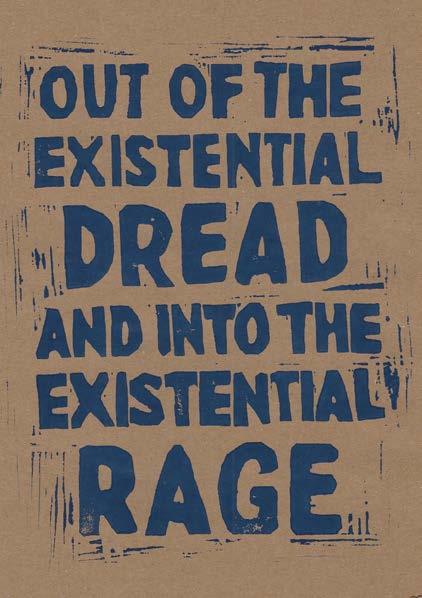
I rage, fingers cracked open, scraping your skin until it bleeds, and still I want to hold you, to touch you soft, but my hands? they carry the weight of a world that never held me. I am fury wrapped in silk, eyes gentle, but my soul? my soul is a tempest. Does this mean I am a lie? Or is it that the truth is too wild for you to see? Rage was passed down like a legacy, worn on our backs like woven cloth, my mother wore it, and hers before her, bodies of stone, hearts made of fire. Indigenous and bold, our blood burns in forgotten tongues, mountains in our bones and oceans in our eyes. We have always raged. Always will. I love you, but I am afraid to let myself melt for you— I have been forged in anger, tempered in the furnace of a world that forgot us. It burns, it cuts, it leaves me raw and restless, wanting to be soft, but terrified that softness will make me disappear. I have been running from myself before I knew how to walk, a stranger to the skin I was born into, hiding in corners, waiting for the world to be kind. But the world was never kind. It wanted me to quiet my roar, my fire, wanted me to shrink into a shape that would fit their cage. I refuse. So now I rage. I need someone to kiss the dark parts of my spirit, to hold my storm with open hands, to see me, to see the rage and still love what remains. I need to put this fire somewhere, need it to rest, to cool, but the burn is all I’ve ever known. So I need to feel something else. Something not made of ash.
SOMEONE COME AND KISS MY RAGE
by Farah Bejdadi


by Troty

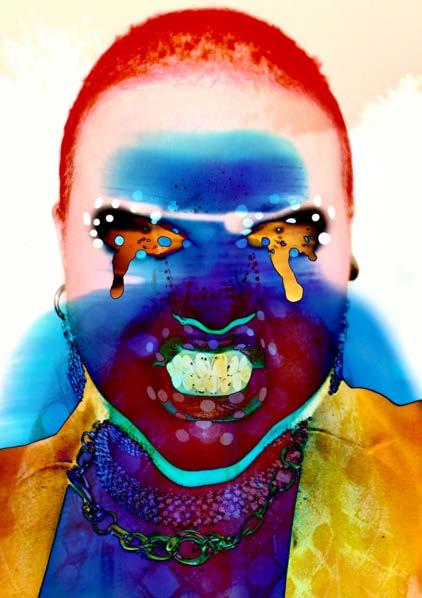
I fill my mouth with female rage
by Julia Marie
it’s a tiresome truth that there’s no tolerance for a woman’s anger so when a storm starts brewing behind my belly button and my eyes fill with water so hot and steaming it feels like my gaze could break the space time continuum but never the silence in my empty mouth
my spiky tongue can’t form the words for punching pain all the way down my throat
my tense and strong abdominal wall contracts I gag and spit besides it all a densely woven hairball
each string and strand of golden rage I swallowed I loudly laugh with shining teeth and set it all on fire
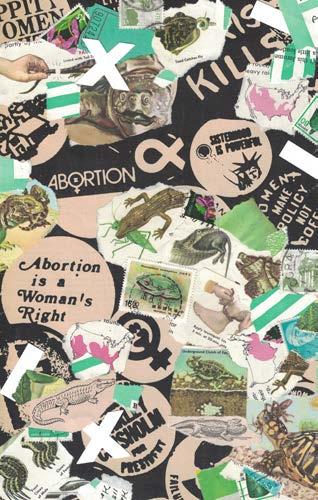
by Liz Walker
RAGING VOICES From Post-Election USA
Few elections are as closely watched as the U.S. presidential vote. From the inside, by the majority of Americans divided between Democrats and Republicans, and those oscillating in between. And also from the outside, by global onlookers eager to know the outcome of this particular election that doesn’t just shape internal politics, but also sets the tone to the rest of the world on what to expect from one of the heavyweight global political powers. The 2024 vote set itself apart from the rest in the relative predictability of its contestants, but unpredictability of the outcome – and in the fact that several communities had much to lose. Trump’s second term – despite its chaotic messaging and conflicting decision-making – has clear objectives in mind: backtracking on the rights of women, queer and immigrant Americans, undermining rule of law, withdrawing from countries in need and, most importantly, making (more) money. And to achieve these ends, befriending big business, tech giants and fascists is not out of the question. Now that this agenda is fully in motion, what of the US citizens and residents who now witness and experience attacks on their rights and identities as the new normal? Are they scared, anxious, grieving? Probably. And are they raging? Most definitely.
This piece combines a range of raging voices from post-election USA, to look back on what went wrong with the last election, take stock of the (terrifying) trends that are unfolding at present, but also look towards the future – what can be done by those who refuse to stand on the sidelines in silence?
Aftermath: drained, demoralised but driven
Some were sure, some were scared, others were sceptical. Common to all were the feelings that followed the announcement of Trump’s second term. Some had invested heart and soul in the Democratic campaign, certain that it was not only the right choice for them, but the one that most Americans in their right mind would choose: “Devastatingly, I was so sure. I hate to admit that now. Working at Harris HQ, surrounded by campaign leaders and dedicated volunteers, we all felt it—the momentum, the energy, the certainty that we were part of something unstoppable. It never even crossed my mind to prepare for the possibility of losing. How could we? We were on the right side of history, and surely, goodness would prevail. Looking back, that confidence feels naïve, and it’s painful to revisit.” (CM) Others were torn in between bad and worst, between two parties that both would continue supporting Israel’s killing and destruction in Palestine and surrounding territories: “I watched my Syrian husband’s pain when voting for Kamala Harris because the alternative is just terrible, but at the same time knowing that the Democratic party are putting his friends and family in serious danger and destroying his home country.” (RA)
In the aftermath, the feelings of defeat, disappointment, but also fear, were felt by all, in particular at the fact that the “motivating factor of hatred” guided the Republican campaign and seemingly spoke to large swathes of the American people (CW): “The anger and let down of the majority of the American population who voted who decided to bring someone back into office who caused so much confusion, suffering and division. … I have lost what little trust I had in the future of the American people to help our country move in a direction of sense, empathy, or at least a shared reality.” (LG). And this goes beyond this particular election and the specific campaigns and policies promoted, “it’s about the way leaders talk about people, the tone they set for the next generation” (CM), which denigrates the identities and rights of millions of American people.


Trump’s win is deeply scary for communities living in fear of attacks on their identities, but also for everyone wishing to access basic services and have their fundamental rights upheld. “I’m scared for my potential child living in a country where the regulations around clean air, water, treatment of hazardous material are all being undermined, where the education structure we have in place is being threatened, for continued limited gun regulation and the violence that ensues and kills children.” (LG) One option is to leave the United States to escape from a government that deliberately does not guarantee support and protection of its people: “My partner and I have discussed moving with his additional passports out of fear of very real violence occurring or need due to medical concerns.” (LG) But for many, leaving is not an option…
Facing the facts: fascism is back
Most knew what a Trump win meant in terms of far right-leaning politics, but few would have predicted that it would go this far – all the way to outright fascism. The first few weeks of the presidency provided a clear preview of what to come: “a coordinated attack on basic, fundamental rights and freedoms of US citizens, residents and migrants, as well as beneficiaries of US-funded development programs abroad.” (Anon). More worryingly, the Republicans now exert control over the executive, judicial and legislative branched of government, so the country is likely to “continue to see decisive blows to human rights, social justice and sustainable development both domestically and internationally.” (Anon). In the midst of unabashed fascist gestures, a flurry of far-right executive orders and hate-inducing speech illustrate the government administration’s push to break the norms and standards of politics and diplomacy,
the tone towards those in power remains (too) cautious: “naming and opposing American fascism has become so unnecessarily difficult in the realm of institutional politics.” (NC). While some pushback has happened at the state judicial level, the Supreme Court is unlikely to exert checks on Trump’s executive decisions: “I’m deeply concerned about the Supreme Court of the United States and the ability of federal judges to serve as a bulwark against Trump. The judicial system is already skewed to the right due to the disproportionate number of Trump-appointed justices and judges, any additional appointments would be devastating.” (CM)
This populist tone can be clearly felt in the discussion on immigration. While it has always been a contentious topic, past politicians have always threaded cautiously on a topic affecting a majority of Americans. Now, the status quo has clearly shifted to a full-fledged anti-immigration campaign, where human beings with sometimes years in the US are being treated merely as ‘aliens’ on foreign soil. In a country built on immigrant labour and priding itself of providing opportunities to ‘dream’ of a better life, immigrants now feel unwanted and threatened (LG) – at least those who have precarious legal status, while mill/billionaires can simply pay for the ‘golden’ visa tabled by the new administration. It is therefore impossible to separate the electoral result from “systemic racism and misogyny [that] remain part and parcel of our
political establishment, which was founded (and in many ways still run) by white, wealthy men.” The ‘rejection’ of Kamala Harris in favour of Donald Trump seems an illustration of this deep-seated opposition to – and fear of – women, people of colour and minorities gaining power. And the somewhat misguided idea that, as a result, the white male ruling class would lose from this power shift: “On the surface, Kamala Harris - as a Black and Brown woman - represents a ‘threat’ to this state of play, and the US media hellscape coupled with her vitriolic opposition did the work of contributing to racist, sexist narratives against her and her agenda.” (Anon)
Finally, looking outward, the Trump administration’s stance is equally hellbent on looking inward, pushing to profit the most and sacrifice the least of ongoing conflicts across the globe – some of which it has actively or indirectly fuelled or started: “While the administration seems to prioritize a general ‘anti-war’ rhetoric, when it comes down to the rights and well-being of folks most impacted by these global conflicts (e.g., Palestinians, Ukrainians, etc.), it places US interests before all (i.e., ‘America First’).”
Those behind the votes: usual and unusual suspects
The typical Trump voter is what you would expect – but this time around, the reasons for their vote were arguable more deeply anchored in disinformation narratives powered mainly by social media. Trump’s self-projection “as a kind of political maverick” (NC) appeared to appeal to many Americans as well as the misguided hope that he would be able to ‘fix’ the economy and support the millions of Americans struggling to make ends meet, may have pushed some to prioritize economic policy over other core issues, such as reproductive justice (CW). In addition, social media played a decisive role – as a new “playground for extremists” (RA) –in labelling certain news and outlets as ‘liberal’ or woke’, “pull[ing] people away from receiving real objective news and steer towards entertaining, fear inducing, simplification of news.” (LG). These disinformation tactics had a clear impact: “In conversations with undecided and Republican voters, I saw firsthand how deeply
right-wing propaganda had shaped their perceptions. Many dismissed Kamala Harris as unqualified, often citing sexist misinformation, including the false claim that she “slept her way to the top.” (CM). Worryingly, many of those who readily embraced these narratives were younger people, young white men in particular, increasingly “turning to more conservative and regressive political narratives in the current landscape.” While this is a symptom of a larger push-back against feminist and inclusive policies, a fear-induced grab to safeguard traditional perceptions of masculinity, “watching the shift of young men to the right feels like both a terrifying political trend and a personal attack. When the rights of all of your fellow female peers are at stake, that’s personal.” (CM).
While it is tempting to solely blame the ‘usual suspects’ for the Republican win, Trump’s voter base seems to have increasingly expanded, speaking to a wider range of voters interested in disrupting the status quo of traditional politics and US governance. For one, “Trumps anti-corruption argument goes far [and] general distrust with the establishment.” (CW). This includes more and more young people, not only leaning into Trump’s anti-establishment politics, but breaking with traditional political parties all together: “US citizens my age and younger [29 years old and younger] are completely disillusioned with our political establishment - to say the least. I know many peers of mine who either abstained from voting this election cycle or chose to vote third party, citing mostly a deep disappointment in Democratic leadership on both domestic and international issues” (Anon). Not only that, but many white women, Latinos and Black men voted in favour of a system oppressive against their own identities: “Americans who voted against their own interests [were] just voting for themselves—they were auditioning for acceptance into the white male power structure. And the saddest part? It won’t work. No matter how hard they try, they’ll never truly be let in. They’re just pawns in a game rigged against them.” (CM)
At the end of the day, the reasons for Trump’s win and Harris’ loss are both “frustratingly predictable and deeply unsettling. At the core of it, there was a powerful mix of fear, misinformation, and cultural backlash. … Because
too many people are willing to abandon their own for a seat at a table that will never really be theirs. And because, at the end of the day, some people would rather burn it all down than share power.” (CM)
A win for big business and money makers
What stands out particularly from the outcome of this election, is that it did not only represent a win for the Republican party and its supporters, but also a very public win for big business. Not to say that previous races did not have significant private sector involvement and influence – as U.S. politics are notorious for their shady links with private companies and wealthy donors – but for the first time, there was decisive publicity and courting of Trump and his political allies by multinational companies. Somehow, Trump’s win made away with ethical reservations and saw a parade of tech CEOs showcasing their support, not only by attending the inauguration, but also immediately adopting Trump policies such as the push against DEI hiring processes. The cause? Likely a mix of seeing an opportunity for profit under a President uniquely associated with making more money for American businesses; a sense of fear that unalignment with this administration would negatively impact companies; but also a group of predominantly (white) male CEOs riding the pro-masculinity and anti-woke wave to the fullest.
Whatever the cause, “that there is such an outright influence of specific people and their business needs on such a large reaching scale is terrifying” (LG) and sends the clear message that “money goes before anything” (RA) and that the ethical line between public service and private interest has been purposefully erased. The fact that an unelected official with clear business interests in the tech and social media industries has been appointed to head a Department in charge not just of these specific policy areas, but also of human resources across the state apparatus is not just outrageous, but dangerous: “anything that makes Elon Musk happy is a net-loss for the human race.” (NC). In fact, it is not just that private interests have trumped public ones – it is that the public
sector is deliberately being undermined, civil servants with a wealth of knowledge and experience fired, and crucial development aid to countries facing outbreaks, famine, conflict and displacement scrapped from one day to the next.
As things stand now, this is playing out like a bad apocalyptic movie – so,
What next?
These elections are not an isolated event confined to the US political bubble. Rather, they reflect and confirm a political tone around the globe that rejects promotion and support of fundamental rights, the recognition of identities and diversity, and, democratic governance as a whole – in favour of economic growth, business and investments, and hard-line policies that limit self-expression and the recognition of individual and differentiated rights and protection. Despite what Trump and his team want to project, this populist logic is not American made, but spans all corners of the world including Argentina, Hungary and India. The difference, however, is that until now the US has had its hands deep in various international contexts – from its funding to NATO and UN agencies, to its role in ceasefire and peace mediation in Palestine and Ukraine – and its shift towards an America first policy and a both nonchalant and lecturing attitude towards (former) allies has put the rest of the world on its toes, to say the least. So far the response to various US U-turns in foreign policy have engendered rather shy responses – notably on tariffs, Greenland, Gulf of Mexico. While Europe talks of standing on its own and China barely bats an eye, populist and far-right agendas keep gaining ground in Europe and Latin America while authoritarian regimes strengthen their grip on power in Africa, Asia and the Middle East. On the international stage, prospects of resistance to the Trumpian narrative remain bleak for now.
But within US borders, among the people most vulnerable and affected by Trump’s policies, there is still some hope on the horizon: “We’re not gonna let up -- none of us
will. Because we can’t. This means speaking more unabashedly about our abortion stories, developing greater networks of mutual aid or just becoming really scrappy and strategic ahead of 2026 and 2028. The right wants us exhausted, divided, and demoralized— but they’ve underestimated us before, and they’ll regret it again.” (CM). But to rage and resist means to confer and commune, so there is hope in promoting “a resurgence in collective action and resistance to these concerning trends both here in the US and abroad. People-led mobilization across movements, sectors and geographies have accelerated progressive, transformative social justice and rights-based agendas in the past and have the potential to do so now and in the years to come.” (Anonymous) One example is the Movement for Choice based in Washington DC, especially vulnerable to attacks on reproductive rights: “Right now, we’re taking it day by day. Our focus is on creating safe, joyful spaces for people who care about reproductive justice and on supporting the abortion providers who are on the frontlines of this fight. They’re doing the hardest, most important work, and we’re here to stand with them however we can.” (CM).
In conclusion: “it looks like some things are going to stay bad, some things are going to get worse, and any good comes from us. It’s true what they say, at least for now: we keep us safe.” (NC)
by Mathilde Betant-Rasmussen
With contributions from: Caroline M., Carol W., Lauren G., Nicholas C., Roselil A., and others.


Q&A with Caroline Motley, Movement 4 Choice Founder
Caroline Motley is a graduate student at George Washington University’s Trachtenberg School of Public Policy and the founder of Movement for Choice (M4C), a nonprofit supporting reproductive justice through grassroots fundraising and community events. She previously served as a volunteer coordinator in the Harris Presidential Campaign, leading large-scale field operations in battleground states. In her free time, Caroline enjoys long walks, thought-provoking podcasts, learning to play the piano and plotting the downfall of the patriarchy.
Movement for Choice is a DC-based nonprofit advancing reproductive justice through community care, joyful movement, and grassroots action. We organize donation-based fitness classes, mutual aid, and storytelling campaigns to support abortion access and reproductive freedom — especially for Black, Brown, queer, and trans communities. As a proudly feminist third space, we build community power through embodied activism, unapologetic advocacy, and revolutionary joy.
[RAGE Zine] What were your key motivations for working for Harris HQ and on Kamala Harris’ campaign? What was your role exactly?
[Caroline] Honestly, deciding to work on the Harris campaign was the easy part. The hard part was actually getting the job at HQ—it took a lot of persistence. I wanted to be on this campaign because I knew this election would shape not just the next four years but the next several decades. And not just in the U.S.—for people around the world, especially those most vulnerable to bad policies.
At the core of it, my biggest motivation has always been fighting for women. There’s a Yiddish word, beshert, which means destiny or fate. It’s also used to describe a soulmate. I think of gender equality as my beshert—the thing I was meant to fight for. More specifically, I joined the campaign because I care deeply about reproductive freedom and making sure marginalized communities—women, immigrants, LGBTQ+ people—are treated with dignity. To me, this is bigger than policy. It’s about the way leaders talk about people, the tone they set for the next generation. I worry about what young men, in particular, are being told about masculinity, that somehow their power or happiness comes from putting others down. It’s a dangerous lie.
At Harris HQ, I managed the “Surge Volunteers”—tens of thousands of people from “blue states” who traveled to battleground states every weekend to knock on doors. This was only possible because the campaign had the money to fund it, which is pretty rare. I went on a lot of these trips myself, traveling from DC to rural Pennsylvania, and I’ll never forget the people I met—a father fighting for his transgender child, a Latina woman with undocumented loved ones, a young woman terrified about what would happen to her reproductive rights. When I think about my time on the campaign, I think about them.
Did you have to defend your point of view on the elections to people around you? How did that make you feel?
I worked on the Harris Presidential Campaign, where part of my role was leading volunteer groups in rural Pennsylvania. Our challenge was twofold: persuading voters to consider supporting a Democrat in the first place and ensuring registered Democrats showed up for Harris.
In conversations with undecided and Republican voters, I saw firsthand how deeply right-wing propaganda had shaped their perceptions. Many dismissed Kamala Harris as unqualified, often citing sexist misinformation, including the false claim that she “slept her way to the top.” These moments were particularly difficult for me, as my instinct was to push back defensively. Despite feeling completely disgusted and insulted, I was forced to make a conscious effort to stay composed as the goal was to hopefully change their minds. A key to effective persuasion is to practice tolerance, patience and understanding. As a feminist who has never shied away from confrontation in my life, this was incredibly challenging for me. I did my best to focus on presenting facts about Harris’s extensive qualifications and engage with voters’ concerns to find common ground.
How would you describe your feelings in the lead-up to and during the elections?
Devastatingly, I was so sure. I hate to admit that now. Working at Harris HQ, surrounded by campaign leaders and dedicated volunteers, we all felt it—the momentum, the energy, the certainty that we were part of something unstoppable. It never even crossed my mind to prepare for the possibility of losing. How could we? We were on the right side of history, and surely, goodness would prevail. Looking back, that confidence feels naïve, and it’s painful to revisit. I believed so deeply in what we were fighting for that I never allowed myself to imagine a different outcome. We fell in love with a dream and America broke all of our hearts. We wanted better for this country than it wanted for itself.
Can you describe what it felt like, as a campaign staffer and personally, when Harris lost the election?
Oh man. I still get choked up thinking about it. The moment that sticks with me is an email HQ sent out when the results started coming in. The subject line was We feel good. A few hours later, it was over.
On November 5th, I walked out of the voting booth feeling weightless, convinced I had just cast my ballot for the first female president of the United States, a champion for the people and women, most of all. For months I was surrounded by people who felt just as certain as I did. “We’re going to win this thing,” every all-staff meeting started.
And then, within hours, that certainty crumbled into something I can only describe as grief. As the votes were tallied, I sat frozen in disbelief, my mind unable to process what was happening. By 9 p.m., my body caught up to my mind—I found myself over the toilet, throwing up from anxiety, something I had never experienced before. That feel-
ing—stunned, motionless horror—never fully left me. It settled in, lingering beneath the surface of everything. Only now am I learning how to live with it.
I actually feel a little sick when I think back to that night. We gave everything we had. It felt like losing a loved one. We were exhausted, drained, and just... devastated.
Who are you most angry at and what are you most angry about?
This is a tough one. I’m angry at a lot of people. Honestly, I’m always angry at white men—because, seriously, fuck you for voting to uphold systems that oppress everyone but yourselves. How original of you. But what really makes my blood boil is young men voting for Trump. How are you 18 and already so jaded and angry? At 27, watching the shift of young men to the right feels like both a terrifying political trend and a personal attack. When the rights of all of your fellow female peers are at stake, that’s personal. That said, I don’t expect much from them. What really stings—the thing I can’t shake—is the Americans who voted against their own interests, their own identities. I’m still trying to make sense of it. Specifically, the Latinos, Black men, and white women who backed Trump. I guess they’re just voting for themselves—they were auditioning for acceptance into the white male power structure. And the saddest part? It won’t work. No matter how hard they try, they’ll never truly be let in. They’re just pawns in a game rigged against them.
Why do you think so many voted for Trump/against Harris?
Many people voted for Trump or against Harris for reasons that are both frustratingly predictable and deeply unsettling. At the core of it, there was a powerful mix of fear, misinformation, and cultural backlash.
First, there’s the fact that right-wing propaganda is *wildly* effective. I saw it firsthand while canvassing—people genuinely believed the most absurd, baseless lies about Harris. The right has mastered the art of weaponizing misogyny and racism, and Harris, as a Black and South Asian woman in power, was an easy target. She was never going to be judged by her credentials alone, no matter how extensive they were.
Then, there’s the shift of young men to the right. It’s not just ignorance—it’s entitlement. It’s the panic of people who were promised they’d always be on top, watching the world change around them and scrambling to protect what they think is theirs.
And then there are the voters who went against their own interests. The Latinos, Black men, and white women who cast their lot with Trump weren’t just voting for a candidate—they were chasing proximity to power. Somewhere along the way, they decided that aligning with white male supremacy would serve them better than solidarity with their own communities. And the cruel irony is that it won’t work. They’re still pawns in a game where they’ll never truly win.
So why did so many people vote for Trump? Because fear is a hell of a drug. Because misogyny and racism are baked into this country’s DNA. Because too many people are willing to abandon their own for a seat at a table that will never really be theirs. And
because, at the end of the day, some people would rather burn it all down than share power.
What next? What will the next four years look like for you and/or those around you in this political context?
Oh gosh. I think the next four years will look like good trouble. We’re not gonna let up -- none of us will. Because we can’t. This means speaking more unabashedly about our abortion stories, developing greater networks of mutual aid or just becoming really scrappy and strategic ahead of 2026 and 2028. The right wants us exhausted, divided, and demoralized—but they’ve underestimated us before, and they’ll regret it again.
As the Founder of Movement for Choice, how will your work be impacted by the election? What are the key things you’ll be doing to continue the fight for abortion rights and bodily autonomy over the next four years?
I think about this all the time. Movement for Choice is based in DC, which makes us especially vulnerable to attacks on reproductive rights. The clinics we work with provide care to people from all over the country—people who have to travel here because their states have made abortion nearly impossible to access.
Right now, we’re taking it day by day. Our focus is on creating safe, joyful spaces for people who care about reproductive justice and on supporting the abortion providers who are on the frontlines of this fight. They’re doing the hardest, most important work, and we’re here to stand with them however we can.
Given your experience working on Harris’ campaign and leading a reproductive rights nonprofit, this election has impacted both your personal and professional life. How do you navigate the emotional weight of it all? How do you manage your anger and use it as a force for movement-building, solidarity, and community strength?
First of all, I really appreciate this question. Because if I’m being honest? It’s fucking hard. Some days, I just can’t do it. I stay in bed and avoid everyone. I’ve also had moments where I snapped at someone in a MAGA hat... and I’m here to say that it actually felt... really good.
The only advice I have is to let yourself feel everything. The grief, the rage, the exhaustion. Don’t bottle it up. But also, do your best to find joy where you can. For me, that’s through laughter, especially with the women in my life. No matter how bad things get, we still have each other.
Movement for Choice was born out of grief after the Dobbs decision, and yet, despite everything, this community has grown and persisted. That’s what keeps me going— knowing we’re still here. We’re still fighting. And we’re not going anywhere.
For more information about Movement for Choice, visit: movementforchoice.org
To my fierce Black girls, The world has no fucking idea what to do with your rage. To understand the heat of grief pressed into your bones and the spark of rage tucked beneath your tongue is to understand legacy and power—it is to understand the many who came before and those who will come after. That fire is life within you. It’s carnal, it’s true, it’s natural. Your rage is not a curse.
To my tender Black girls, You carry so much that the world doesn’t see, but I am asking you to feel your rage. Channel the fire. It will be misunderstood—labeled as anger, madness, recklessness, or a lack of love. And that is exhausting. But let them fear it. They cannot take what you won’t give up.
Your rage connects you to your softness. Your rage is the channel to intimacy. Your rage is sacred. It’s palpable. It’s powerful. Your rage is a gift.
To my luminous Black niece, You are the love that sets rage ablaze. I see the light in your eyes that I hope never dies. The fire that burns is the same—let them feel your rage. Felt, it is power. Protect it to protect yourself, to honor your mom, your grandma, and every Black woman who carved a path for you to follow.
Let them witness your rage. Your rage is sacred.
To my Black boys: I’m counting on you to do better. I know your rage lives inside you more than you realize. Accountability is not a cage—it’s a bridge, a force that brings us closer and makes us stronger. If you do not feel what you need to feel, your rage will consume you.
Understand that your rage is tied to the way you treat Black women and girls in this world. Your rage, when understood, is power. Your rage, when honored, is transformative. Your rage transforms.
To all of my young Black children who can’t feel their rage: You have been handed a heavy world that demands your silence, your strength, your restraint. I see the rage you’ve been forced to swallow, and I know what it’s doing to you. But you don’t have to hold it alone. I love you. I need you. Not just your strength, but your softness, too.
Let your grief be heard. Let your rage breathe.
I know this is scary. I will teach you how to wield it without it destroying you. If you learn to hold it, to let it breathe, it will set us free.
I imagine you breathing without weight on your chest. I imagine you speaking, and the world listens.
I imagine you laughing loudly in spaces where no one tells you to be quiet. I imagine you crying without apology and being held until you are ready to stand again.
Not feeling your rage will silence you. Not feeling your rage will kill you. But feeling your rage will save you.
Your rage is not the end. Your rage is where we begin.
Let it burn as a beacon of what’s possible.
Your rage is passion. Your rage is sacred. Your rage is legacy. Your rage is power. Your rage is love.
Rage Is Where We Begin by
Keni Nooner
Essays on Reaction Drop I: Rage

When I didn’t have the strength to react

Essays on Reaction Drop II: Abuses Trap
WATCH ESSAYS ON REACTION DROP I & II HERE
by Mädchen Vivi
STICKERS AND MARKERS, RECLAIMING AGENCY THROUGH DIY ACTIVISM
Métro-boulot-dodo is a French saying used to describe the mundane Parisian’s routine: taking the subway, working and coming back home (only) to sleep. It was popularised in May ‘68 to describe the alienation caused by modern urban life, which contributes to a passive attitude towards the world. This common saying often comes to mind during my morning commute, where half-asleep, I try to squish myself into the crowded rush-hour train. However, sometimes something jolts me out of this routine: a giant out-raging ad.
On the subway platform walls, 4x3 meters of glossy paper are selling me something. A witty slogan, an edited picture, a carefully curated colour palette, an out-of-the-box fresh-out-of-businessschool branding concept, and most importantly a promise: this object will make me happy and fulfilled, this service will solve my problems, this product will make me an acceptable woman, get it or get FOMO. The question “how is such a sexist/ tone-deaf/out-of-touch publicity still possible in 2025?” often comes to mind. These ads are made to create desire, to stimulate consumption and by doing so they shape our identities and ideals. These images reinforce gendered and limiting stereotypes, they sexualise and commodify women. In Simulacra and Simulation, Jean Baudrillard explains that the domination of images, labels and signs blend fiction and reality to form a hyperreality. The advertisements that surround us do the same, they create representations that become more real than the things they represent. The images of women portrayed in ads are shaped by the male gaze and the Photoshop lens. They encourage diet culture, fast-fashion, skincare obsession, forming an unreal flawless self, a fantasy that is “Killing Us Softly.” In La société du spectacle, Guy Debord explains that the ever more presence of images representing an idealised version of life, form a spectacle. The spectacle of capitalism leads to a form of commodity fetishism, where consumption takes on religious aspects. Guy Debord invites us to break free from our consumer/spectator role.
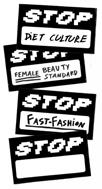
Day after day, these ads made me so angry, that one morning I tossed a thick black marker in my bag. I called it ‘‘mon crayon de la colère’’ [my rage pen]. I used it to comment and draw on ads, pointing out their negative impact on women, the environment or even the right to housing. This was my way to not actively refuse to endure these images and reclaim space through action. The small act of highlighting a sexist ad may have a big impact as thousands of passersby will look at this modified image. I then wished to engage others in this idea. With my sister, we created DIY stickers and shared them with friends. Collectively, we started sticking them on every ad that enraged us: bank ads, miracle skincare ads, diet clinics ads, fast fashion retailers ads, blatant gentrification ads as well as advertisements including actors involved with domestic assault and violence against women.
What does creative defiance mean to you? What is it you want to speak up about and collectively resist against? With the following tutorial, we invite you not to stay an observer of oppressive images and instead rip them up, cross them out and respond back.
by
Myfawny & Arianell Boudry

WE INVITE YOU TO ‘SAY STOP’
Step 1: Rip this page with the ‘STOP’ sheets out of the zine
Step 2: Cut out the individual ‘STOP’ sheets
Step 3: Keep the sheets, some tape and a rage pen in your bag at all times
Step 4: Be mad, but beware of security cameras
Optional additional step: Be furious with friends, spread the feminist rage!
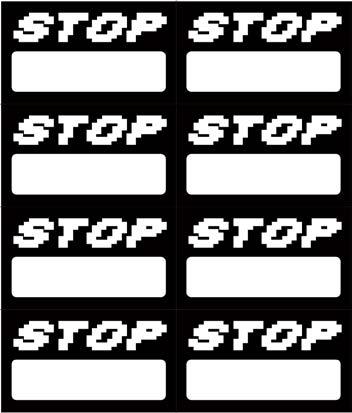
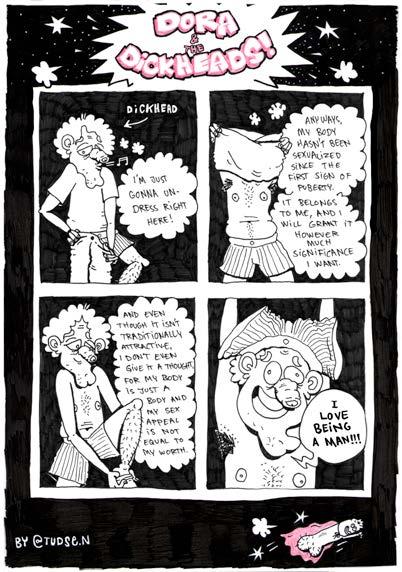
Lady Bluebeard
Because of you. I sleep With a gun chained to my waist And feel the trigger From a mouth afar mouthing Your name. Or a song that almost Reeks of you, despite borderline Innocence. What is innocence anyway: The bloodstains wiped off The smallest key. A bargain From your wives. I used To love the idea of your Hidden Chamber. Shame On me. (Out, damned spot.) I must atone. So I invite you to my old mansion. My gift to you: A set of keys, a trigger tag warning not to open My underground chamber. I vaguely shrug And said You wouldn't want to see
by Cally Lim
My buried babies that belonged to you. As if. Of course you snuck down to peek And see rows of skinless sinners Hanging like freshly struck from The Tower. A smoking house of Zeuses For Karma. A wall with Yael’s nails and hammer. You never knew my namesake A huntress. (And take my milk For gall) And in You go, motherfucker. Mark the last words you hearken: Every child I birth from now on Shall sleep with stories of sin And do my biddings: Intergenerational revenge, divine Patricide, the scythe slitting Sisyphean-skinned. Feet to fingers.




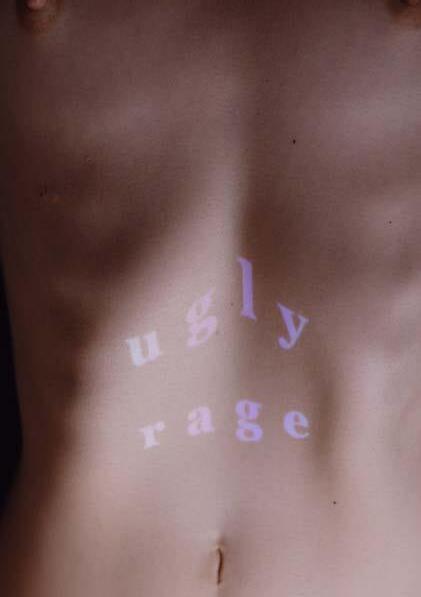
mine is a tender body hungry for a scream, angel soft thighs dying to make a scene, a good-girl-mouth staying silent to extremes, shards of broken words under this pink tongue framed by lip-gloss sheen. my half-moon fingernails clawing on shimmering skin, a nightingale’s song eating up an ugly rage I am holding within. they tell me I was built for love and love and love I am oh so (inhale)
soft (swan)
tender (willow)
Girl, so insane
delicious (fleshhhhhh but oh... no the blood, they love my wide-eyed notnotno- my insanity
I am so sorry I am so
hahahahaha (exhale)
& Body by Laura Griss
by
Mike Haas
Words
Photography
1 a: In the movies, she’s a scarred tale of monstrous rebirth, a reverie of feminine rage wrapped in the silky ‘tsismis’ web of urban legends. The old people, with their tobaccosteepled fingers and birdlike chippers, tell the story of her past. They say she was a hardworking woman who left the country and came back as a monster with a blood-rot sinister clot in her eyes.
b: I was nine, naïve, and my navel brimmed with questions; my great-grandmother warned, ‘She hates children. She eats them mercilessly.’ My fear is a prey of metallic tang, a virile blood lure for the woman with a knife-sliced scar on her face. From the dusk-speckled sky, my hands touched the fields, and I thought of her talons clawing into the ground. The land is a clone of the color of my skin: flesh-browned with a pepper of sun boils and wheat-whittled scars. My mom beckoned for my name, a thunderclap amidst the frivolity, and it’s a warning, it’s a calling, it’s a haven from the woman who feeds. Her name is
2 a: extracted from the Ilonggo word for hack ‘labo.’ The word paints a picture of grinning chainsaws with their brrrrr brrrrrrrr brrrrrrrrrrr teeth and bite. It is the splice of cutting tools with their gleaming sliver of moon retaliating against the dark.
b: They say she ate her own children. Crack open her body, and it’s a visceral shrine of macabrity and decay. Her name was immortalized in a media mythology: Maria Labo. The first film being released in the year 2015 was an exploration of feminine monstrosity representation through the art of visuals. And I remember being in my beigecramped room — the movie hightailing to its climax and curdled brutality. My lips were snarled from the shadowy reflection of the television, and I couldn’t help but be awed in fear by the slight resemblance. It was also the same year
3 a: that my father cradled alcohol bottles to his chest, nursing the comfort of lulled agony with every sip. The legend narrates that Maria Labo disappeared after witnessing the volition of her crime. The old people berated; she was never gone. She roams the creeks, crannies, and concaves of dark.
b: It was also that year I prayed to the moon but still dreamt of hair explosions, mouth dripping in blood, bared teeth, and talons clenched in fists. Every face for every nightmare was a woman with a jagged scar on her face. Soon,
4 the nights were drenched in knuckled bruises and star-shaped imprints. The blood trickling from her chin morphed into beer-spilled, curdled words from a man’s beard. Film strobes against tangled hair didn’t speak of wilderness; it sang the audacity of decrepitation clenched with stubby hands. The teeth, ready to bite unlatched like Pandora’s box, were the color of urine and macho authority. The fists rained like bullets, and Maria Labo seemed to be a better fate
5 to become. Perhaps Maria Labo is a reminder of terror of what a woman could become in the face of grim darkness. Is she a mirror that wives hold up to their faces so that they can see the allure of unrestrained destruction? Or maybe in
the commodity of anger, she became an unpopular metaphor for fire. A wick of flame within teenage girls’ bodies, innately nurtured with neon nails until the day it is permissible to transform as a conflagration. I watched Mom drag herself away into the cavity of wrath as they toppled the decks of her testaments of unjust. They branded her testimonies irresolute, unfaithful, and a destruction to the sanctity of marriage. Is it love
6 if it’s invasive? When Maria Labo tore the flesh of her children, did she ravage and consume her creations whole? Was it for the purpose of reclaiming her power and identity? When she crouched into the ground and lost herself willfully into nothingness, could it be called autonomy? Did she lick her nails clean and wipe her tears with guilt? When she ripped bodies into pieces and devoured the whole of them with insatiable greed, was it a way to abscond for revenge unfulfilled? I asked the questions
7 to my great-grandmother when she called Mom hysterical. When Maria Labo succumbed to her violence, her lips bristling with viscera, her eyes goaded with remorse, did she become herself by choice? Or was it predetermined by ruination? She gave me a terse gaze and whispered, ‘You are still young. You know nothing.’
8 and I keeled and snarled and bit through the tears. My hunger was unsatiated with a patronized pulse, but I knew through my fury. I knew everything with a canine grit. Did Maria Labo repel against her morals and regress into her primitiveness? I wished I knew so I could birth it as an answer to annihilation.
by Dan Aries
Maria Labo
Woman as Object: Bouquet

by Juliana Stankiewicz

A FF ECTIVE (T)E RR OR:
HYSTERIA AS A FEMINIST DIALECTIC OF RAGE
revolution from the margins of reason / the abject as archive / the politics of affect: feelings (often dismissed as irrational or unmanageable) are potent weapons against domination, power, and oppression—both intensely personal and politically explosive. there is an urgent need for us to embrace emotion, rage, and desire not just as individual experiences but as deeply transformative forces that challenge the status quo, disrupt traditional structures, and engage in a kind of revolutionary terror—a visceral, embodied violence against systems of control, through emotional upheaval.
‘‘In my life politics don’t disappear but take place in my body’’ – Kathy Acker, Blood and Guts in High School
‘‘… of all the nervous disorders of the fin de siècle, hysteria was the most strongly identified with the feminist movement’’ – Elaine Showalter, The Female Malady
hysteria (my definitions):
diagnostic framework serving as a way to neutralize women’s critiques of the political economy, framing their distress as individual pathology rather than as a legitimate social critique.
women’s emotional responses to systemic inequalities frequently framed as personal issues to be managed through therapy or medication, rather than as political responses to structural oppression.
I. prologue:
a symptom or a spell? hysteria as suppressed rage
hysteria has long been framed as a medical and pathological condition, often attributed to women’s supposed irrationality, emotional instability, or weakness. however, beneath this medicalization lies something far more profound: hysteria as a form of suppressed rage. rage that has been demonized, denied, and categorized as pathological in order to prevent women from expressing discontent. hysteria was historically used to suppress expressions of power and anger, particularly in women and marginalized groups. what if the symptoms of hysteria—screams, fits, and emotional outbursts—were not signs of illness but rather signals of a politically charged resistance to the subjugation of women, queers, and racialised others?
diagnosis or incantation?
hysteria as a summoning, the pathology of power affective glitching
HYSTERICAL RAGE IS MY MOTHER TONGUE
disjointed
I am ripe with the juices of despair
they archived our bodies in the taxonomies of masculine terror aberrations
brittle medical etymologies
THEY TRIED TO MEDICATE MY RAGE, I MADE IT CONTAGIOUS INSTEAD
spoke in tongues not yet written untranslatable we glitched the language of the empire
witches, neurotics, diseased our bodies faulty architecture in their eyes spasm in the archive, flesh opens with a rupture feral twitches, she bleeds a narrative loop, stammer, around and around, repeat ill or merely illegible?
generative, explosive force the abject disturbs identity, system, order. leaky, squishy, dripping with contamination disciplinary regimes produce mad mad mad bodies delirium transgression
excessive affect disobedient pleasure incendiary speech gendered contamination subversive eroticism
II. history: the weaponisation of hysteria against women, queers and the racialised other
hysteria is not a private affliction; it is a collective wound. It has been the cudgel of history, swung with surgical precision against women, queers, and those deemed ‘other.’ Ancient Greece was the cradle of this diagnosis, and it spread like a virus, infecting every institution built on the bones of patriarchy. the hysterical woman, the ‘irrational’ queer, the ‘disorderly’ racialized body—all were made objects of fear and control. The diagnosis was not just a medical tool; it was a political one. hysteria was wielded as a sword, cutting down dissent, locking bodies into submission. It erased the political edges of their rage and replaced them with the soft patter of silence. hysteria was not the disease; it was the cure for the unmanageable, the unruly. an excision of the political, a sanitization of revolt.
methodological position. demonized, they rewrite theology in reverse. sexually voracious, autonomous, they reclaim the body not as shame but source. wrath, justice, vengeance—not emotions, but epistemologies. the scream is not a symptom, but a syntax. myth becomes manifesto. desire becomes data. their hysterias were not errors but rebellions—madness as resistance, prophecy as rupture. these figures pulse in our veins. they are not history. they are method. they are memory. they are coming back.
III. references: the curse of iconoclasts
Medusa, Cassandra, The Maenads, The Furies, Lilith, Eurydice—each one returns, not as symbol, but as scream. feminine archetypes become hysterical insurgents. they inhabit us, glitch through us. the monstrous feminine, the cursed prophetess: they are not broken—they are breaking. language, order, narrative. silenced, enraged, dismissed by fathers, kings, and doctors. yet they rise, again and again, in archives and dreams. ecstasy, frenzy: their weapons, their truths. refuse to be domesticated! this is not metaphor; it is a
IV. the body: visceral resistance
a body that cannot be read is not a failed text / the archive is also flesh.
constructed as a deviant body, a body out of place, a body out of time, a body that does not submit to the rules of containment. the institutionalization of hysteria is not just medicalized violence; it is the epistemological formation of control itself. hysteria is flesh. hysteria is not mind or spirit; it is the body making itself known when words fail. the body recoils, contorts, erupts, and in its violent rebellion, it refuses to submit to the rituals of compliance. women’s bodies, queer bodies, racialized bodies—these are not just bodies, but the battlegrounds of history. the body that shakes with rage is a body claiming its space in a world that seeks to confine it. the shaking, the twitching, the convulsions—they are the body’s rebellion against the slow death of subjugation. here, the hysterical body is not fragile; it is feral. it is the rupture of norms, the body becoming a site of resistance, a place where power
leaks out in fits and tremors. to be hysterical is to be alive in a world that wishes you dead.
V. language & speech: contagious noise
words were never meant to be silent. the ‘hysterical’ woman, the ‘unruly’ queer—they speak with a voice that is not ‘irrational’ but raw, unfiltered, unapologetic. hysteria is the contagious noise that seeps through the cracks of the language constructed to keep us in line. speech becomes a virus: it infects, it spreads, it resists the neat little boxes assigned to our experiences. when the system tells us to be quiet, to subdue our emotions, our desires, our anger, we speak louder. but our speech is not allowed to be heard. it is called madness, shrillness, hysteria. it is noise, unworthy of the sanctity of the state’s language. the noise of hysteria is the cracking of the facade, the bubbling up of suppressed truth. it is the refusal to be sanitized, the desire to be heard in all our beautiful chaos.
order, their rebellion against unpaid labor a mere emotional aberration. the hysterical woman, the neurotic, the manic—she was the problem, not the system that confined her to domesticity, to silence, to labor that never counted. capitalism and patriarchy, entwined like twin serpents, used hysteria to dismantle any critique that threatened their control. a woman who rages against the system is not revolutionary; she is simply sick. hysteria, then, is the political diagnosis, a way to label dissatisfaction and dismiss it. it is not the anger that needs to be addressed, but the body that dares to express it.
VI. politics: hysteria as political and social oppression
hysteria is not simply a diagnosis; it is a political act, a tool of containment. in the capitalist order, women’s dissatisfaction was always framed as hysteria: a personal failure, a private issue. their anger was pathology, their dissatisfaction a mental dis-
VII. sex: the erotics of madness / orgasmic hysteria
to be hysterical is to be sexual in a world that seeks to control sexuality. pleasure and madness are entangled; hysteria is not just a lack of control—it is the failure to conform to sexual norms. the erotic is bound by the leash of patriarchy, but hysteria is the unshackling of that leash. it is the body that refuses to comply with sexual regulation, the mind that rebels against the control of desire. in the histories of hysteria, we find not just the pathologizing of female desire, but its erotics, its wildness, its refusal to be neatly packaged into the acceptable categories of sexuality. hysteria is the madness of pleasure, the explosion of desire into realms unexplored, untamed. the very act of claiming sexual pleasure is itself a political act—a refusal to be silenced, controlled, contained.
VIII. psychology: mental illness as symptom of the patriarchy
disorder is a weapon when wielded properly
the mind is a battleground. in the realm of psychoanalysis, the diagnosis of hysteria was never about the mind alone—it was about power. the unconscious was a domain, not of personal turmoil, but of patriarchal repression. mental illness, particularly hysteria, is framed as a personal failing, a weakness, a neurotic outburst that has nothing to do with the crushing weight of societal norms. and yet, it is here, in the diagnosis of hysteria, that the patriarchal roots of mental illness are most visible. the symptoms were not just psychological, but political—emotional distress was an understandable response to a world that demanded women to be subjugated. hysteria was the tool used to erase the political roots of mental illness, to make the personal a diagnosis, rather than a form of collective resistance. the mind, too, was colonized, subjected to the rule of reason.
IX. community: reclaimed madness
madness is not the enemy. madness is the revolution’s call. in contemporary feminist movements, madness is not a pathology to be cured, but a badge of honor—a symbol of resistance against the sterilized order of things. reclaiming hysteria is not a retreat into victimhood; it is the forging of a new language, a new way of seeing and being. feminist thought has dug through the wreckage of hysteria to unearth its radical potential, to unearth the rage it represents.
to be hysterical, in this sense, is to be uncontainable, a force of nature that cannot be subdued by any diagnostic framework. intersectional feminism reclaims this madness, recognizing it not as a symptom of weakness but as a revolutionary act of survival, a protest against the structural inequalities that seek to erase us.
X. future: rage as cure & collapse
the future of hysteria is not passive. it is radical, it is alive, it is the possibility of transformation. the future of hysteria is the unshackling of those who have been told their pain is personal, their rage irrational, their bodies disordered. the future sees hysteria not as something to be cured, but as a weapon, a tool of rebellion. it is the spark of revolution in every tremor, every fit, every scream that challenges the status quo. the future of hysteria is not its end but its evolution—into something fierce, untamable, and most of all, unapologetically political. it is the cry that will not be silenced, the body that will not conform. tied between urgency & activism.
from archive to algorithm, and from protest to screen — hysteria is now in the glitch of the ether. a disorder refusing to be coded out.
hysteria is critical affective terrorism. it is the counterforce to all that seeks to govern the body through control, to erase its affective and emotional power through pharmaceutical prescriptions, through institutionalization, through gendered impositions of silence. to be hysterical is not to be broken; it is to be unshackled, to tear through the very membrane that has kept
the radical potential of affect—the heart of political agency—suppressed. it is to speak when others want silence, to move when others want stillness, to reclaim the body when it has been told that it does not have the right to its own existence.
XI. epilogue: hysteria, a site of feminist subversion
hysteria shall become what it was always meant to be: a weapon. not a fragile illness, but a tool of subversion, a flag of revolt. in the ruins of a world built on oppression, hysteria rises as a symbol of feminist power—a refusal to be rendered mute, a defiance against the systems that would keep us in chains. no longer a diagnosis, hysteria is the spark of resistance, the scream of a body that will not be controlled, the voice of a woman who will not be silenced. the hysterical subject is not broken, but whole—a radical force that confronts the world in all its chaos and beauty. it is the revolution that begins in the body, in the mind, in the voice. hysteria is not the end, but the beginning of a new world—one where power is reclaimed, not just resisted.
by Nadia Razali
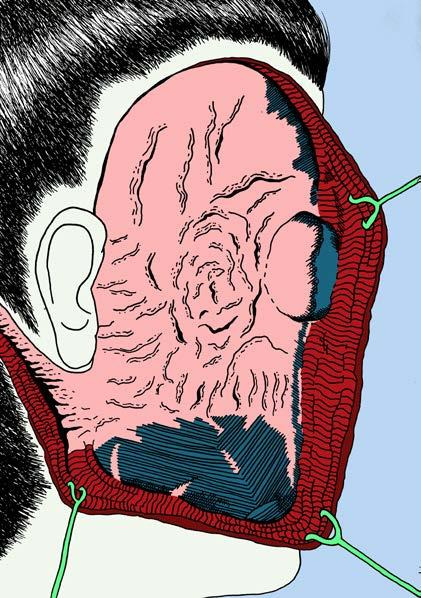
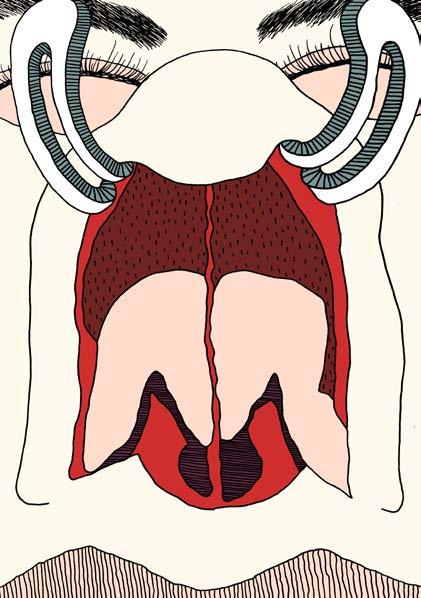
[Short] feminist
poem on sex
Ultimately, everything still turns around youthankfully it's 2023 and the impassivity which leaves our shoulders cold has started to decrease; not that we haven't lived through that too.
But when you wanted so much for me to come and you did everything to achieve that outcome with consent and care for my desires, that time that I just couldn't -with the small bite high up my inner thighthat time when satisfaction was kept inside my tank without overflowing; everything was ruined because your goal was not accomplished. You told me that it's not feminist to not want to finish [I couldn't] and that this wasn't sex [it was]
I told you that last time with you I had an orgasm [it was true] but I think that something changed in between.
by Myrto Apostolidou
Along with feminism pornography is also on the rise but there's a thing that remains; in the end even my own pleasure is a selfish prescript of theirs and they don't just give because I'm human but rather because I'm a cup reward lottery.
You always know something better than I do about me about my body about my feminism all these musts of yours from which not even a single one did I ever define.

by Prantip
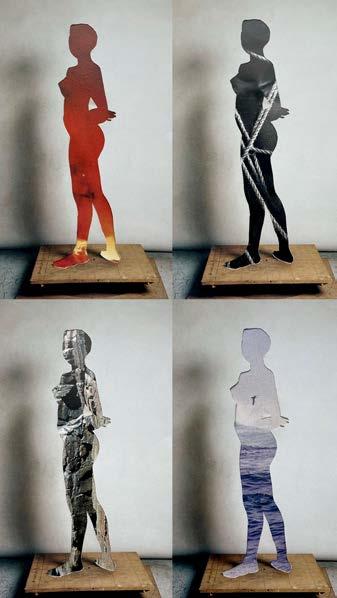
24 Hour Snuff Pornography
£10.99 A Month
Sometimes the television set doesn’t switch off.
Weight Watchers chocolate chip ice cream; calorie counts on your menus; skinny girls frowning in the mirror with an “I look so fat today” dangling from their tongues.
Another woman murdered by her partner.
The boys in the library rating girls from 1 to 10, the greed in their eyes and their hands, the way that I’m too tired to be disgusted.
A lid to stop the spiking. A get home safe message. My ex calling me crazy. Endlessly swiping left or right.
Another woman murdered by her partner.
A changing room exchange of looks.
A lingering feeling of shame flickering in my intestines, like cigarette papers on a flame.
Roe v Wade overturned by the Supreme Court of Justice.
Another woman murdered by her partner.
The violence hidden in summer: scratching an under-bra rash, thighs chafed red, a too-short tank top and stares from middle-aged men when all I want to do is breathe.
But I can’t breathe because
She was thirty-three. She was walking home. He cut her up and put her into a bag when he was done with her.
Buried her in the woods like a dog scraping over its shit.
And my ex didn’t understand why I cried all day, why I’m still crying, why we are all still crying more than a year later.
Anti-acne cream. Anti-ageing cream. Anti-cellulite cream. Sweatshop fashion that gets thrown out after one use. Crossing to the other side of the street at night.
Another woman murdered by her partner.
A TikTok comment calling me a fat pig. A TikTok comment telling me to go hang myself. A TikTok comment begging me for a blowjob.
The way I never felt safe at secondary school. The way that sometimes I still have nightmares.
Boys will be boys and boys will touch me where I don’t want to be touched, boys will tell me they want to rape me and boys will grow up into men and
And?
Another woman murdered by her partner.
by Hannah Corsini
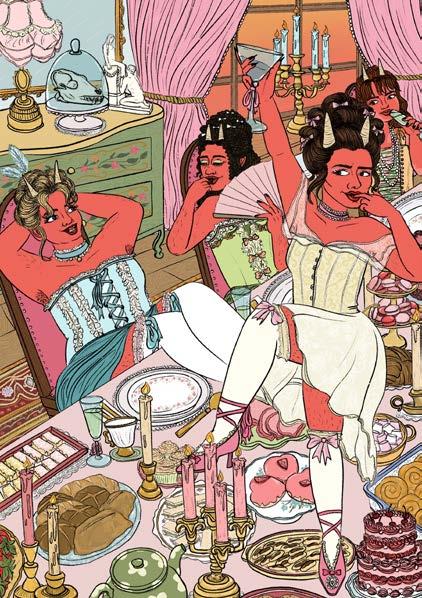
by Annika Hyeonjin Julien
I think that you are vile, but I welcome you to gnaw Feast away at this feast of me and I’ll forget what it is to be raw Feast away at rotting me I beg you! Feast away! Pick at every piece of me You are my sweet decay I want to lay here nothing Not blood, not flesh, not bones I’d love to be here nothing among grass and dirt and stones Can you do that for me? Do you think you can be that for me? How close to nothing do you think that you can make me be?
Summoning Vultures
Hungry, hungry vultures! I lay here newly dead Stop stalking, stop flocking and come peck at me instead I can see that you are peckish Your eyes are bulging black, eating at me from above Your glare is an attack
My belly may be bloated and my skull may be infested, but my heart is ripe and bloody and it wants to be ingested
THE SCREAMING DISEASE
If there are silent diseases creeping up on you, endometriosis is the screaming disease – its symptoms often very painfully present, with people begging to be diagnosed, but just as often overlooked or done away with, accompanied by ‘this is completely normal’ or ‘you are just exaggerating’. This is a very personal account of screaming about my disease and endometriosis may look and feel different for every person.
The first time that I heard about endometriosis was in 2016, when the singer Halsey had just been diagnosed and began to openly talk about this chronic illness. About the years of debilitating pain that had been misdiagnosed, about being called a ‘baby’ for complaining about period pains, about suffering a miscarriage shortly before having to go on stage. One year prior, they had helped me to realise that I was bisexual and while that realisation was immediate, something that I knew to be true from the first moment that the thought crossed my mind, Halsey now made me suspect something that would subsequently take almost a decade to confirm.
In the wake of this first moment that a name was put to an experience that had been following me since I had my first period at age 11, I began plucking away at myself, unfolding parts of myself, metaphorically diving into my cells, membranes, and beyond to start understanding my own body. But it did not need a lot of internal exploration to easily draw conclusions and recognise myself in the symptoms that she spoke about. At this point, I had been on birth control since around 3 months after that first red spotting. Not to control any kind of birth. Not as a form of contraception. Simply to control the thing that usually comes as a sign of no impending birth once every 28 days – that is if your hormones and cycle are as meticulously controlled as mine became after that first gynaecologist visit.
So, with my new knowledge of endometriosis and a hypothesis that could explain 9
years of suffering to accompany me there, I went to my gynaecologist. She was a sweet woman, a kind woman, an older woman, whom I had chosen carefully after going to many different practices and having traumatic experiences. [...] But she was also a woman who was not trained on endometriosis, a relatively ‘new’ area of research in 2016, and she quickly dismissed my hypothesis.
Many ultrasounds, debilitating episodes of pain, and four years later, I was returning from my Master’s degree in London. My latest period before the move had seen me lying on the brightly orange floor of my miniscule en-suite bathroom, incapacitated, writhing in pain, crying in desperation. However, my hopes for diagnosis were higher this time. My previous gynaecologist had retired and the one to have taken over her practice mentioned endometriosis on her website – surely a good sign! At the first chance I could get, I found myself back in the waiting room, nervous and hopeful at the same time. What followed was the same procedure I had already encountered many times before and would continue to encounter many times after. An ultrasound. Nothing of note. Maybe a cyst? Could explain the excruciating pain that immobilised me, especially near my ovaries – not that it was in any way visible now. But not to worry, not to worry, no lasting impact on my health or fertility in any way.
Four further gynaecologists. Four more years. Conversations at parties during which I excitedly exclaimed, “oh, you have endometriosis?”, offending the per-
son across from me with what seemed to be joy at their pain – when it was a misplaced hope of finding my own way to diagnosis through the account of theirs. Four more years of pain, of doubting myself, of thinking myself dramatic, of suddenly developing bouts of fever before my periods, of countless hot water bottles, painkillers, whimpers.
And then, at last, a gynaecologist who took me seriously. An ultrasound that for the first time seemed to not be of the norm. And with it, a referral to a hospital with an endometriosis centre. Not even a month after this appointment, I found myself in yet another waiting room, once more nervous and hopeful at the same time. The answer was swift, so swift that I wondered how it could be that it followed 18 years of suffering, 9 years of mentioning endometriosis at every gynaecologist visit: one of my ovaries, attached to my uterus by scar tissue, typically seen in endometriosis.
Slow steps taken out of the hospital. The pitiful faces of the medical personnel that I had asked about whether my fertility could be affected burned into my head. An empty feeling as I tried to process.
And then the rage. The rage of having gone through countless ultrasounds before, the last one not even a year prior. The rage of having described again and again the pain I felt around my ovaries. The rage towards myself for not having trusted myself more and insisted to go to an endometriosis centre before, having trusted countless medical professionals over my lived experience. The rage becoming infused and saturated with disappointment and sadness, as I called my mother crying in front of the hospital, as I broke down in front of my partner on our anniversary date that night, trying to come to terms with the information that the endometriosis had gotten worse enough to not only
now been easily visible on ultrasounds, but to potentially impact my fertility – with an operation to remove the scar tissue around my ovary risking to do more damage than good, as the doctor said.
How is it, I have since come to wonder, that I have heard countless stories of people with a uterus, who know that they will never want to have children, being told that certain treatments are not viable for them as they may impact their fertility, while the same medical system, the same society makes it so difficult for people with endometriosis – a disease which has been proven to affect fertility intrinsically – to be taken seriously and get diagnosed?
What should have felt like a win, the glorious moment of having been right all this time, no longer brought with it any kind of victoriousness. My path in life had always been quite open, I had never dreamed of a specific job or profession, all I had known when I was young was that I wanted to be successful in whatever I ended up doing, that I wanted to have a career I could be proud of, that I wanted to make my own money, become financially stable, and then, one day, become a mother. Of course, there are many ways to be a mother, many reasons why one would decide to become a mother or not to become a mother. But one of these decisions had just become less likely for me. “You will find out how much your fertility is impacted once you start trying to have children,” the simultaneous hope and fear that is set to accompany me for the years to come, while I take the measurement of a hormonal IUD to ensure that the condition is at least not getting worse.
For now, all I can do is wait. Wait to find out how deeply my fertility is affected. Wait to find out if the little spiral will do its work to make my periods vanish or more bearable after landing me in a hospital bed for two hours upon its insertion.
But while I wait, I will continue to be filled with the rage of this being an experience that I am not alone with, but one that affects every 10th person with a uterus. The rage of having heard countless stories of struggles like my late diagnosis that took 18 years and of knowing that I am set to hear and read more stories like mine for the next 18 years.
And then there is the constant question. The question if it IS every 10th person with a uterus that is affected, because if it is so difficult to get a diagnosis, then how do we know that it is not every 7th person, every 5th person, or even more? There are two people on my team at work, a third one looking to be diagnosed, and three people at the party I went to last weekend. And now I know that there is me – and if you feel like this text speaks to you, maybe there is you, too.
https://www.reddit.com/r/endometriosis/comments/1cr7sjm/the_endo_survival_guide/
https://endometriosisnetwork.com/endo-hub/drop-gendered-language/
https://www.endofound.org/the-endometriosis-resource-portal-for-people-of-color
https://endoviolence.com/
by Veruschka Haas
by Mathilde Clear
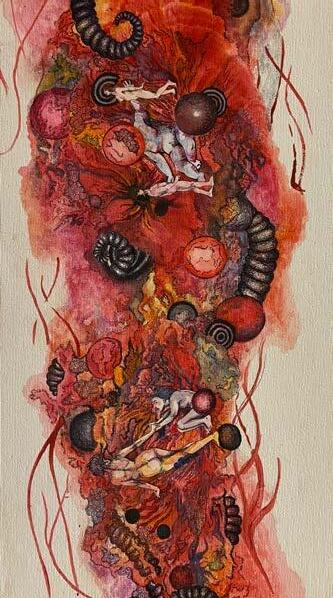
Allow Me to Be is an essay film born directly from my experience of life governed by the phases of my menstrual cycle. I created the project alone, with every shot crafted during different phases of my cycle. This makes the work deeply personal and authentic – an honest window into a rhythm that defines and controls much of my life.
Allow Me to Be
The title, Allow Me to Be, extends beyond my personal cycle. It reflects a broader frustration with how women often feel the need to seek permission to exist as they are – from family, friends, workplaces, and societal institutions. It is a call to let me, and all women, live in alignment with our natural rhythms, free of judgment, expectation, or imposed standards.

I feel the essay is raw and unfiltered, much like the cycle itself and the process of shooting on film. It presents a simple yet powerful visual universe dominated by black, white, and red. These colours, combined with imagery of instinct, nature, city noise, animalistic freedom, emotional vulnerability, strength, and fear, portray the phases I go through before, during, and after menstruation.
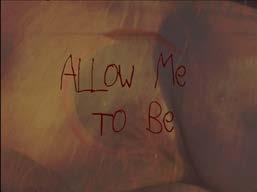
by Mai Hedvig Lyngby
WATCH ALLOW ME TO BE HERE
Pleasures Erased and Withdrawn. Female Thought in the Academy
The clitoris leads a subdued, secluded, secretive existence. At least in the academy. The pleasures associated with thinking it and making space for it in thinking are suppressed. Philosopher Catherine Malabou looks at how exactly this occurs. In a beautiful short essay entitled Le plaisir effacé. Clitoris et pensée [‘The Pleasure Erased/Withdrawn. Clitoris and Thought’], she shows the subtle work that disciplines and diminishes the space afforded the clitoris and its thought in the work of a wide range of thinkers as diverse as Giorgio Agamben, Simone de Beauvoir, Jacques Lacan, Andy Warburg, Luce Irigaray and others. Invoking the double connotations of the word effacé, Malabou directs our attention to the ways in which the clitoris is not only ‘erased’ but also ‘withdrawn’ and with it pleasure and thought, or perhaps, the pleasures of thought, as her essay title indicates. For anyone in the academy and beyond this should be a cause of rage.
The pleasure of thought withdrawn and erased is my concern here. I take the idea of the plaisir effacé is displaced out and away from Malabou’s philosophical context and into the academy where it can help raise radical feminist concerns about female thought in the academy. With Malabou, I would refuse to essentialize binaries or bodies and distance myself from TERF positions while retaining a commitment to radical feminism, the feminine and the violence directed at women. The feminine is to feminism what purple is to lavender as Alice Walker puts it. ‘Me Too’ has been crucially important for directing attention to ways in which sexual harassment and abuse has been foundational for the uneven distribution of the pleasure of thought in the academy. This said, ‘Me Too’ has left untouched the more subtle processes marginalizing female thinking pleasures. Perhaps it has even reinforced them? Managers and colleagues can now rightly claim to be aware of harassment and have processes in place to counter it. They might not be perfect of course. Those who use them find themselves banging their heads against institutional walls that remain intact. Their heads do not (to speak with Sara Ahmed). However, the processes are there and can be worked with and perfected. So could we not just rejoice at achievements to be perfected? I think not. The implication would be to declare the pervasive processes erasing and withdrawing female pleasures in the academy irrelevant lest they involve physical, sexual, harassment. Even such more subtle processes are well known, much discussed, old and sadly entrenched, addressing them remains crucially important.
In this Malabou’s provocative discussion of clitoris connection to thought as pleasure erased and withdrawn. Here, I pick one corner of that provocation that shows the processes generating the disappearance of the clitoris from the psychoanalytical thought of Jacques Lacan, an iconic figure of French psychanalysis. The dismissing, dominating and directing the thought women pointing to the significance of the clitoris ensured both the erasure and withdrawal of their thinking. Dissecting analogous processes in contemporary academia paves the way for reflexive engagement with them, breaking an active, but mostly unthought, complicity with them and encouraging active strategies affirming the pleasure of thought in the academy.
Dismissing
Lacan famously insisted that there is no sexual relation. For him it was all about the discours amoureux [loving discourse]; the fundamental modality of erotic experience. For Lacan, discourse generates the erotic pleasures of women and men, equally. Embodied relations dissolve
in disembodied discourse. Adding to this, Lacan also insists that women and men understand and experience the loving discourse differently. They therefore cannot and do not meet. They have no sexual (it is all discourse) relationship (they do not meet). The clitoris, for Lacan, is an insignificant little body with no obvious connection to the sexual relations he claims do not exist. It is unworthy matter. It deserves no attention in the higher realms of abstract psychoanalytical thought.
Does this ring familiar? Does being dismissed as a body, present, material, occupying a given space, of little significance resonate? It certainly is something most women in the academy will quite routinely experience. Their bodies occupy officers, positions and spaces dismissed as irrelevant. The ‘Can you get the coffee please?’ addressed to the woman in the workshop or the empty glass handed her, thoughtlessly locating her among the catering staff at the reception following it, show that even when she tries to appear in the significant spaces she is often dismissed.
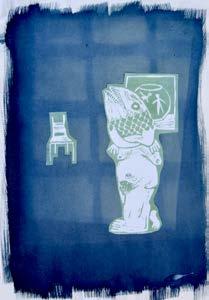
The collegiality of the philosophy research group in one of my institutions is an egregious case in point. Malabou writes extensively not only about the phallocratic quality of philosophical scholarship but also about its somatic shaping of the bodies that enter it, including her own. The philosophy group confirms. It organized any and all of its research focused events without ever including the women from their midst. Their bodies occupied spaces. They were routinely invited to step up to administrative leadership roles. They were not summoned to lead workshops, publications, or doctoral committees. The philosophers insisted that the women were competent and wonderful, just not for the intellectually rewarding roles at hand. This repeated itself with endless variation and distressing monotony in blatant disregard of the fact that the academy including our institution had long since committed to ‘diversity’ generally and the inclusion of women specifically. The philosophy group to repeat is just an uncommonly egregious case in point of what women, I and you, all live through in a academia.
The recurrent dismissal of women as non-worthy of membership in the ‘good collectives’ etches itself into us. As branded by hot irons, it marks female academic bodies that just take up academic space. Branding can neither be brushed off or nor washed away. I cannot know the
effects of the branding on the women in the philosophy group, on their organs, their clitoris or their sexuality. Malabou’s reflections on the effects of philosophy on her own body tells us they might have been far reaching as they are for most women in the academy. I do know that their interests, demeanor, style and language became evermore managerial. Their will to presence became less insistent. Exclusions no longer offended them. As most of us often do, they caved in. Fighting about how to understand relevance is exhausting. Withdrawing to calmer terrains, enjoying the solitary pursuits of pleasure of thoughts at the margins of philosophy group is what its women opted for. Dismissal became a self-fulfilling prophecy. The women did become

more focused and less connected to the research group. Their pleasures of female thought with and in the philosophy group were erased and withdrawn, in the dual sense of a plaisir effacée
A plaisir effacée by dismissal is difficult to counter. In the academy, judgement about relevance, competence and criteria and belonging to the ‘good collectives’ of scholarship are constant and inevitable. To direct attention to the specifically gendered (or indeed more broadly intersectional) quality of dismissal therefore takes careful labor. In part, that labor involves blunt measures that visibilize and valorize women, the female: the clitoris and its pleausures. In International Relations (my scholarly academic discipline), feminist scholars have proposed ‘a new canon’ grounded in ‘women’s international thought’. All main scholarly associations have adopted policies encouraging women to take on research leadership. Such measures matter. They make erasure difficult. A more systematic countering of our tendency as women to withdraw would also help. Solidarity in refusing to be dismissed and encouraging others to do the same, hang on in there, even when it is easier to leave and relax is crucial.
Dominating
Sapping such solidarity is the fact that men somehow always seem smarter, better and most

crucially cooler in the academy. Valorizing and visibilizing women’s thought is therefore uphill work. It requires daring the domination such male semblance affords. Again, Malabou’s account of how the clitoris disappears in Lacanian though provides inroads for understanding the processes at work. Françoise Dolto, a psychanalyst closely collaborating with Jacques Lacan, tries to affirm the significance of the clitoris for mainstream psychoanalytical thought. Lacan asks Dolto to present her work on the ‘female genital libido’ at a congress in Amsterdam in 1960. Dolto accepts. She situates her work firmly within the discussions on the subject that had been ongoing since the 1920s. The consequence, so Malabou, is that Dolto ‘is not really herself. She juggles, circles, wavers and walks on a mine field’. In her effort to ‘keep everything … the only way for Dolto to make herself heard in the cacophony of all the incompatible concessions she is making is to draw on her own clinical experience.’ The clitoris, its thinking and pleasures are erased and withdrawn from Dolto’s presentation. They become illegible (erased) as Dolto prioritizes addressing dominant traditions. As Dolto focuses all her attention of speaking to dominant thought, her own priorities recede into the background (are withdrawn).. The clitoris is enters mainly through Dolto’s clinical observations, leaving the terrain of theory to tradition. Lacan remarks that Dolto’s main contribution is her knowledge of children, relegating her to the position of someone providing useful material for more important theoretical thinkers done by others, such as a Lacan himself. Psychoanalytical tradition incarnated by Lacan’s towering figure is dominating Dolto’s pleasure of thought into becoming a plaisir effacé.
Dolto’s strory will resonate with the experience of many women in the Academy, also today. A literature review that clearly locates an argument within a scholarly tradition and debate is a standard requirement for academic research work spanning from the term paper to the opus magnum. Traditions require respect. The logic of course is that we do not want to eternally reinvent the same wheel. We want respect for what is already there, engagement with our colleagues’ work and so a firm foundation for collectively engaging in the ‘pleasure of thought’. Dolto’s choice of submitting to its domination is therefore one most scholars will make. They have little choice. Grades, peer reviews and other disciplining devices make it inescapable for anyone wishing to survive in academia. What woman in the academy could risk not confirming to the norms of quality research?
Gloria Anzaldùa tried. An icon of radical mestiza, queer, feminist thought who braved all conventions. She mixed Spanish, English and Nauhuatl in her writing. She practiced an eclectic spiritual activism merging imaginaries including that of the Yuraba with her own. She wrote about the effects of hallucinogenic drugs on her own body and sexuality and more. The most
influential feminist scholarly activist of her time, Anzadua’s life was outside the academy. The dominating tradition infuse also critical, radical, feminist scholarship in all its varieties. They have their own authorities that have to be cited. (I am citing Malabou!). This makes establishing what is not already present, not already accepted as part of (a) dominant canon particularly challenging. Thought cacophony of all the incompatible concessions it needs to make. Pleasure is nowhere to be found. Towering traditions generate the hills that scholars have to work their way up unless their pleasure of thought are already at its top.

To the best of my knowledge, there are few shortcuts and no easy ways to the domineering summits of scholarly tradition. Recalling the challenges facing those who walk the trails leading there therefore matters. In International Relations, early feminist scholars persistently did so. It is 20 years since Cynthia Weber wrote an article entitled ‘Good girls, little girls, and bad girls’ in which she showed how the policing of tradition boxed feminist scholarship into categories, dividing them and blocking them from accessing the summits of science. Not letting go of an inkling of radical pleasures of thought she affirmed the right to be bad; to be a ‘killjoy’ as Sara Ahmed thinks all feminists inescapably are. Their ideas help me make sense of my own pleasures of thought and what blocks them but also of what not to do with the pleasures of others. While struggling up the hill of tradition is inescapable in academia, shifting the route, focusing on other hills, perhaps even contributing to their making is equally important. So is allowing other to be killjoys, questioning the beauty of these alternative routes and hills. Today feminists in my field are established. They have a little authority hill of their own in our disciplining disciplinary landscape. So in fact does Dolto in hers. She became a recognized psychoanalytical thinker in her own right.
Lacan commented Dolto’s 1960 presentation saying: ‘Eh bien, pour parler comme tu parles, tu es culottée!’ [To speak as you do, you are cheeky]. ‘Culottée’ references inappropriate female entrance into masculine realms. It originated from women who (contra tradition) wore pants (culottes) for ease when engaging in activities closed to women such as e.g. horse-ride. Lacan was belittling Dolto’s intellectual significance and framing it as inappropriate. He might have sensed the challenge it posed to the domination. Dolto was speaking to psychoanalytical tradition and she was indicating paths for circumventing it — anchored in clinical experience.
Directing
Paths such as Dolto’s are difficult to discern, choose and follow. A sense of significance and appropriateness impairs our ability to see them. They overshadow the attractiveness of alternatives to the scholarly cannon. The conventional paths appear more intuitive and better. Scholarly tradition orients and directs in ways erasing these alternative paths from view and makes us opt to not engage them even if and when we see them.
Malabou recounts an episode of Lacan’s public and well known disdain for Simone de Beauvoir. De Beauvoir had the courage to insist on the significance of the clitoris, writing about the two female sex organs. She maintained its centrality for a distinct sexual pleasure not associated with reproduction, penetration or indeed the loving discourse Lacan located at the centre of sexuality that she must have known. Nonetheless, De Beauvoir gets in touch within Lacan while working on The Second Sex to discuss its psychoanalytical implications. Lacan disparagingly remarks that he ‘does not understand by what orientation’ she does so as he had not yet taught or published much at the time. He answered de Beauvoir’s query by ‘having her note that at least five or six months would be needed for him to clarify the issues for her.’ The exchange stopped at this. De Beauvoir had followed a diffuse orientation. It had directed her to what must have been a humiliating encounter with Lacan. De Beauvoir clearly decided to pursue her thinking and work in spite of it. To simply ignore it and move on.
The diffuse orientation, difficult to understand, that brings de Beauvoir to Lacan is an excellent example of the directing academic thought is subjected to. The directing is often explicit. It comes in the form of instructions by supervisors and (more significantly) peers about where to turn. What to read. What to think. What to consider cool and interesting. You really should have a look at this. You will find it interesting. It really speaks to your interests. It is brilliant. You will find it fun. The debate around it could really do with your contribution. Does this sounds familiar? The mediation of such orienting advice through websites, platforms, online discussions groups, social media, automated suggestions and recommendations from publishers increases and accelerates its diffusion and circulation. As Lacan, many would likely express puzzlement at where exactly the directing impulse comes from. Yet, they would converge around the common sense of direction it generates. As Lacan they might protest it.. They might inquire and ask about it. Still, belonging in the academy is to share this sense of direction that prefigures the choices of pleasures of thought to be pursued.
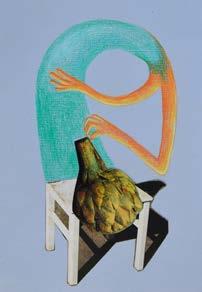
There is nothing deterministic about such prefiguration. De Beauvoir did persist with her intuition that the clitoris mattered in spite of Lacan’s dismissive refusal to engage with her. Directions are never univocal. De Beauvoir picked up different directions orienting her away from Lacan to other psychanalysts — such as Francoise Dolto — who might have been more interested in her ideas? As anyone who
has discussed their ideas will know, sieving through comments and reactions, retaining the helpful and leaving the rest behind is of essence. It is impossible to please everyone. The directions always diverge. Perhaps, as de Beauvoir, we can actively search for such divergences of direction? Perhaps as her we can cultivate a keen, sharp sense of the possibilities plurality opens? The fissures left by divergent orientations and the possibility of widening these are possibilities. Turning them into proper passageways for thinking pleasures is to make space for female pleasures of thought in the academy and beyond for all of us.
Pleasures Affirmed
‘Le clitoris est un anarchiste’ Malabou affirms concluding her essay. As the anarchist, it subverts power, but not in a singular way. This close discussion of the processes by which the clitoris is erased in, and withdrawn from, Lacanian psychoanalysis has shown that its thinking pleasures are subversive in plural ways. The pleasures of thinking through the clitoris subverts the powers dismissing it as irrelevant by affirming its plural presence and significance, the powers dominating it by circumventing routes and by the making of alternatives and it subverts the powers directing it by finding the plurality of the directions and the fissures resulting from these. This plurality testifies to the absence of an overarching, hierarchically imposed, strategy following a neatly defined order. This is bound to feel disorienting for those anyone who like strict rules and clear instructions. However, feminists mostly do not. Feminism is plural. It follows multiple strategies and ideas. Precisely retaining that openness, building alliances of in ways that drive and transform the meaning of the feminine and feminism itself has been its strength.

In the academy much stands to be gained by learning from this anarchic commitment to embodied knowledges that takes thinking with the clitoris beyond female thought, connecting it to thought more generally, without forgetting its feminine qualities. In sum, ending the subdued, secluded, secretive existence of the clitoris, opening for the female pleasure of thought associated with it is of significance for the academy as a whole.
Words by Anna Leander
Illustrations by Alva Guzzini

Death of Koshej
by Liza Shkirando

Nana, they are destroying our planet

by Małgorzata Rumińska
we grew up as SPLINTERS & BLACKMAIL & SMUT in our MOTHERS’ & TEACHERS’ & GODS’ dreams of HARDWOOD FLOORS & BREATH
embroidering SHAME & HOROSCOPES & OTHER MONSTROSITIES onto each other’s palms & CALLING IT SISTERHOOD picking apart every STITCH & TOUCH
decentering 2005 & LOVERS & OTHER OBJECTS OF DISORIENTATION
PAINSTAKING & CATACLYSMIC
are words that come to mind & MAKE IT BOIL
too much has been lost for us to CONFINE & / OR BEND our bodies blessed with PRIDE & FURY born to SPLOOT & TWIRL & WAGE THIS WAR let them sanctify who WE WERE & HATED BEING do not believe them when they say that IRE & WIT & FOLLY have no place in PUBLIC DISCOURSE & SELF-MYTHOLOGY
we can be both LIGHT AS A FEATHER & STIFF AS A BOARD at each other’s fingertips & SO WE MUST RAGE in unison GLEAM & HARMONIZE & BECOME UTTERLY UNAVOIDABLE with INCANDESCENT SAFETY & TAPESTRIES OF OUR TEARS HUNG WHERE THEY ARE UNWANTED
PRIDE & FURY
by Clara Josephine Lykkeberg

by Hailie Cochran
Has not society itself helped to make the individual unhealthy… Why should the individual adjust himself to an unhealthy society?
Jiddu Krishnamurti, Commentaries on Living Series 3
I hate that I have to pay to park downtown. I only go downtown for work—to work the job that pays for parking to go to work.
Even Sisyphus wouldn’t put up with this shit.
I don’t even wanna work in the first place because I wait tables all fucking day for two-dollars-and-some-change an hour while booths full of God-fearing Christians write zeroes on my tiplines as righteous consequence for forgetting their refills and having my nose pierced and for, probably, not saying have a blessed day as they leave church pamphlets in place of rent money and spit mint gum wads into their cloth napkins—somewhere a phone is ringing while a toddler dismantles his dried-out burger patty and American cheese slice, throwing the squishy brown-and-yellow bits onto and into the fake-wood floor that I now have to sweep and—
now that I really think about it, I hate everything
because there is free parking downtown, but it’s in the same parking garage where that guy raped me in a gray stairwell and I can’t even think about parking there without the hands and veins and sweat and IV scars and cigarette ash coming without asking—and I tried so hard to tell CEO Fuckface over the phone that I really can’t park there when I called to appeal the tickets, but profit seems to always trump people—and I think maybe that’s why there are ribbons of lavender and pale pink on too-young wrists—why high-rise ledges seem to turn from vision-board aspirations to hopscotch squares and leather belts start to look like necklaces—society is sick, sure—but the rich write paychecks and prescriptions.
The punchline?—I’m the idiot writing poems about it.
And it feels silly to mention now, but I’m still pissed about parking—because they write the parking tickets, too.
Waitress Broadside
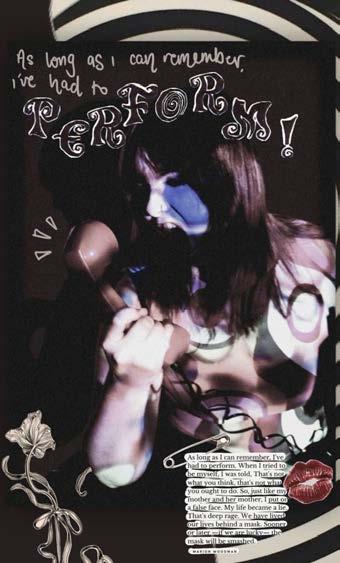
McGowan

Dear people,
by Johanne Pi
Dear bleeding hearts
of artists, you can stop bleeding now, they won’t get away with murder, you will make art and still be whole.
Dear people of color, I am white, and I am sorry that I can’t give you your freedom. It was never ours to take. I wasn’t ever ours to give you, freedom isn’t something to be granted, I’m so sorry it was stolen from you.
Dear Murderers, please don’t kill me just because I have a vagina. Bought or birthed. Please take this message personal.
Dear Oppressors, stop creating oppressed while declaring yourself masters.
Dear Masters of War, listen to Bob Dylan. Stop playing with my world. I am safe and still in fear of bringing children here. Answer Bob Dylans question; is your money that good? I know it buys you forgiveness, but I don’t think that it should. You’re not worth the blood, from our veins or the children in the mud. I’ll stand besides Bob Dylan, to watch over your grave, I’ll walk with the people, till we’re sure that we’re not dead. Dear masters of war, the only thing that you’ve made, is too much fear and too much hate.
Dear Palestinians, I’m watching your mass murder live on television. They say that you’re terrorists, they won’t say your names or your death counts. I don’t know, if you will be here long. I hope you survive and will one day be free, from the river to the sea, in safety and in peace.
Dear Bob Dylan, I listen to your words every new years, to never forget the source or the reason that I’m here.
Dear Robert Carlyle, it might seem silly, but your Rumplestiltskin saved my life and inspired me. Gold crocodile I am forever grateful. You made me happy again, and creative, and then you showed me trainspotting and I survived and fell in love with beat poetry and heroin.
Dear Pink, I would really like some education, and I think I need some thoughts controlled.
Dear Pink, I want arms around me and drugs to calm me and I really just need anything, anything at all will do.
Dear Jim Morrison, you made me fall in love with birds and strangers.
Dear Trans* people, I am so sorry that you die by the hands of others. Your suicides are yours, but not your fault. It is ours. We should have protected you better, and listened much earlier. I am sorry that I can have fake boobs, and you’re denied them if you happened to be born without them. I am sorry that you can’t remove them. I am sorry for everything. For your label as mentally ill. You is not a disease. I am so sorry, that we made you believe that you’re wrong. You are not.
Dear dead tribes, I am sorry for all of the genocides.
Dear tribes that are still alive, I am sorry that we’re still trying to erase you.
Dear Rapists, I hope I was the only one, if not I hope I was the last. There’s so many of you. I don’t think, I will ever truly feel safe. Dear rapists. I am not alone, so why do you tell me, that I’m the only one that feels this way? We are so many, so many that have been raped.
Dear white people, listen to Sons Of Kemet and protests, and take it
personal and do better. I am trying, and I am listening. The whole world needs us to listen. Sons of Kemet, and protesters on the street, is a good place to begin.
Dear white people, listen to Gill Scott-Heron as well. Because whitey is on the moon, while black is getting killed.
Dear John Fante, thank you for your language. Words make more sense on your pages than in any other type of existence.
Dear mentally ill, I hope we get better, I’m lucky and alone to know that I will. I hope you get to join me. I hope you get to grow and be happy. I hope we have room for us, I hope we have care for us. I hope, one day, my case won’t be considered lucky.
Dear Richest, get a fucking grip and save some lives.
Dear suicides, I hope you’re resting in your mind.
Dear directors, let a black person tell a black story. Let a woman tell a woman’s story. Let a trans* person tell a trans* story. Stop making movies about trauma you don’t understand or care for, with some white, skinny man hero who sees the light and free’s the slaves. Slaves weren’t freed by us, but by themselves. Let them tell us their story. We have put enough words in their mouths by now. Let them write a chapter for ones.
Dear history book writers, dead men tell no tales. If they did, you would have been fired for writing fairytales down as facts.
Dear Ukraine, your trauma isn’t popular anymore. The world cared very shortly for your lives.
Dear Sudan, the world never cared.
Dear oppressed countries, I don’t know the names of. The world didn’t even care, to let me know, that you’re suffering. I am sorry.
Dear government, stop making war-machines.
Dear television, show me the protesters and the easy ways to help. I don’t need new oven mittens or diet shakes. I need to help the world, but I can’t do it myself, so I need you, to let people tell me, how and where to help.
Dear Marsha P Johnson, a thank you seems too small but I mean it big and pure.
Dear Gisèle Pelicot, I am so sorry for what happened to you and I know it will happen to many others, but we are changing the side of the shame, and I will do my best to never forget your name or your bravery.
Dear Government, fuck you.
Dear psychiatry, two female writers in Denmark are doing a project called Tender Activism and I need you to listen to them. Their names are Anna Rieder and Sidsel Welden.
Dear psychiatry, I need you to start explaining mental illnesses and symptoms as well as the nurses do to a person going through chemo. I am not drawing a parallel between cancer and mental disorders. I am saying that the information given during chemo treatment is much more specific and regular and talked through. Cancer patients get educated on their illness and possible treatments. I can’t even begin to tell you how many medications I’ve gotten prescribed without anyone telling me what for. I’ve been diagnosed with chronic mental disorders and
not told why or what the diagnosis meant.
Dear writers, thank you for a life that makes sense.
Dear Derek Jarman, you were incredible. I never understood color before you spoke them to me.
Dear Lebanon, I know that Brezhnev took Afghanistan and Begin took Beirut. And I know that Israel is bombing you, I don’t know when it will end.
Dear Syria, Israel dropped a massive bomb attack on you that registered on the Richter scale, but it wasn’t really reported on by the news.
Dear Government of Israel, what the fuck is wrong with you.
Dear people of Israel, I can only hope and believe that you are as devastated as I am.
Dear Mothers of Invention, thank you for ‘We’re only in it for the money’ it is making me laugh and smile and not go fucking insane. But I am becoming slightly obsessive about the tracks.
Dear Pink Floyd, you should’ve removed track 10 and 11 from The Final Cut, but the rest of the album is insane.
Dear people, who’ve gotten their breasts removed through top surgery. Your scars are healing me from a lot of things.
Dear cis-het men, fuck off or come on down to the streets and protest with us. You not raping or not using slurs or not being stupid or not being transphobic is not impressive. I need you to make real efforts and real actions.
Dear earth, I am getting better at protecting you.
Dear Diana Di Prima, I feel protected and sad when you write about your abortion. I feel like dancing when you write about nightmares. I feel like extending love when you write poems to Freddy.
Dear activists, thank you for caring and acting. I am getting better at becoming like you.
Dear artists, the time of irresponsible artists is over. We shall regret it for our little moments of bliss. But we shall be able to admit that this ordeal contributes meanwhile to our chances of authenticity, and we shall accept the challenge. The freedom of art is not worth much when its only purpose is to assure the artist’s comfort. (Quote from Albert Camus’ speech: Create Dangerously). Don’t misinterpret this: I need you to create dangerously and responsibly.


by
jane katzmann

I had speech therapy for a palatal lisp when I was 14 years old. For about six months, my therapist and I looked at the sounds and shapes that my mouth couldn’t form, and worked on the things that I was simply unable to say.

patronized, cut off, and shut down by the men I encounter in academic settings. Suddenly, I am too quiet, too flimsy, too feminine – no matter the strength of my argument, or the insight that I offer up. This feeling of being unable to speak isn’t necessarily new, but is nonetheless surprising.


The task of relearning how to speak was u n e n d i n g l y frustrating. It was physically and mentally exhausting to confront the embarrassment that had always hovered in the background of my way of speaking, and which had been at odds with how much I wanted to be heard. But overcoming this frustration was I felt a new kind of confidence, a sense of pride in introducing myself to new people, asserting myself, and just




I started my PhD almost two years ago and unwittingly ended up in a male-dominated environment, where the men seem far less happy to let me talk. I frequently find myself as one of a small handful of women in the room. Sometimes I’m the only one. I am spoken over,
Why can’t I overpower the attempts to talk over me? Why is the embarrassment of speaking to someone I know isn’t listening so raw? When did I lose my voice in a sea of men?

I am conflicted by my own shame and anger. Each time I am interrupted, I am indignant, but my body reacts before I can begin to think how to talk back. I go red hot, angry, teary. All I want to do is shout:


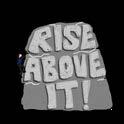
I distract myself from my rage and remind myself that an emotional reaction will brand me as hysterical. I worry about how unlikeable I become if I stand my ground. When a rumour went round that I had yelled at a male professor (I hadn’t, though I wish I had), I immediately panicked that it would destroy any respect I did have. Women cannot be forceful without prefacing our forcefulness with self-effacement, without showing we can take a joke (are they joking?). If I push through, I’m at best a broken record, at worst a bitch. So I hear myself getting quieter and quieter and quieter.

Maybe I care too much. I shouldn’t let it get to me. I notice when I speak up in a class or a meeting that I’ve started to
deepen my voice,
as if masquerading in the male position will somehow trick the men around me into respecting me; as if it will deflect their condescension on to a weaker target. It never really works. They probably think I’m trying to sound sexy.
Of course, the men I speak to – regardless of how vigorously they interrupt – can hear me. I remember this every time a man presents the same ideas I have put forward under the guise of his own genius: he must have been listening, because his ‘brilliant’ thought suspiciously resembles one I said five minutes before.


A lump forms in my throat. I let my indignation fester inside me as I watch a man get rewarded for the same assertiveness that makes women so unlikeable.
I have realized that it is a waste of time trying to become palatable to the men who won’t let me speak. I’m slowly getting my voice back, and I have a lot to say. But I will allow myself that emotional reaction. By confronting the frustration, cursing the injustice, commiserating with the people who have been through the same, forming my words in a new way, and working through the tears, I will relearn how to speak. After all, I’ve done it before.

Words by Izzy Blankfield Pictures by Nicola Stebbing
by Anastasia Kluge
Spirals of Silence: Feminist Rage for Greenlandic Inuit Women
Imagine being a thirteen to sixteen-year-old girl, sent to the doctors while at school to forcibly have an adult intrauterine device (spiral) inserted causing you extreme pain without being informed about what is happening and without you or your parents’ consent.
While this might sound like a distant practice, over 4500 Greenlandic Inuit girls and women were subjected to a Danish sterilization campaign between 1965 to 1975. Their futures, choices, and autonomy were stripped away without consent.
Assi Chemnitz Narup, a Greenlandic politician, captured the devastation in one sentence: “Numerous talents and individuals, dreams and laughter, strength and wealth of ideas have been lost to us as a people and as a country.”
A LEGACY OF CONTROL
Denmark’s claim on Kalaallit Nunaat, Greenland, stretches back centuries, officially colonizing the land in 1751. Like many colonial powers, it imposed laws that controlled Indigenous lives—including their reproductive rights. In 1929, Denmark became the first European country to legalize sterilization on “abnormal” Danes, targeting mentally disabled, alcoholic, or “promiscuous” women.
At least 4’500 young girls were affected by the sterilization campaign between 1965 and 1975, with more recent claims dating from 2014. It wasn’t until 2017 – fifty years after the facts – that a Greenlandic Inuit woman, Naja Lyberth, publicly shared her powerful story. Only in 2022 did Denmark finally
commit to an investigation, following international pressure. The findings are expected to be published in 2025, but for many, justice remains uncertain. Whether Denmark will acknowledge its responsibility in a meaningful way remains to be seen.
Forced sterilization has long served as a tool to oppress minority groups and remains a global widespread practice. While state-supported eugenic policies were most known to be used under the Nazi regime, enforced sterilization programs against women of minorities were recorded in Peru, Slovakia, China, Czech Republic, Hungary, Japan, Belgium, Canada, Denmark, Germany, Norway, Sweden, United States, Romania, Namibia, Russia and many more. Shockingly, today only 9 EU Member States explicitly criminalise forced sterilization, while at least 13 still permit certain forms. Addressing this enduring issue requires continued efforts to secure justice for victims and protect the rights of Indigenous and marginalised groups, beginning with holding states accountable for their obligations under international law.
A VIOLATION OF RIGHTS
The international law violations that will be mentioned need to be seen in their wider context. These forced sterilization cases are a blatant display of structural violence originating out of colonial and discriminatory policies. We are talking about systemic and institutionalized harm inflicted upon Indigenous women. By not only inflicting physical and psychological trauma but truly aiming to eliminate cultural and social identities, enforced sterilization is a devastating tool of cultural violence. The intersectionality of discrimination with the targeted populations mostly being women from minority groups is crucial to note. The true violence of these actions needs to be considered in light of the expected role of Indigenous women as leaders in their community, highly respected through their role as “givers of life.”
As Marie Petrussen, who was just 16 when inserted with a spiral, testifies, “I didn’t feel like I could do anything – we had no rights.” Indeed, the forced sterilisation campaign by the Danish authorities violated major human rights provided for in international law.
The experience of the Greenlandic Inuit women, feeling as “they forced their way into our innermost organs” testifies to the violation of their right to physical and mental integrity, and their right to privacy. The concept of “body territory”, rooted in decolonial and indigenous feminist theory and reproductive justice, further highlights that their body, as their primary territory, was violated.
The declining birth rates testified to the violation of the right to found a family and to reproductive self-determination, with more than half of the women of childbearing age at that time in Greenland having a spiral inserted. Indeed, a testimony claimed “we all know someone, our cousins or other women, who have been unable to have children”. The Danish authorities also deprived these women of the right to be fully informed or give free consent, by hiding the sterilization procedure and its consequences from them.
“How would people react if it was Danish women instead of Greenlandic?” asks one of the victims of the campaign. The campaign indeed reveals the intersectionality of the violation of the right to non-discrimination committed by Denmark based on the womanhood and indigeneity of the targeted group.
The forced sterilization by the Danish authorities furthermore qualifies as violations of several grave international law crimes. The widespread forced sterilization campaign by the Danish government for a period of at least 10 years or more on 4’500 women, qualifies as a crime against humanity, as defined by the International Criminal Court. With testimonies describing the forced sterilization in Greenland as “having knives inside me” and remembering being “in so much pain that I just sat down in the snow”, there is no doubt that these actions would amount to the threshold of torture. Enforced sterilization is also considered as a tool of genocide by multiple international Conventions, Rapporteurs and Commissions. What really makes these violations international law crimes is the institutional and structural nature of the violations, which can be found time and time again in genocidal and colonial policies of forced sterilization.
PATHS TO JUSTICE
With an official report only expected to come out this year, Denmark’s accountability and reparations are long overdue. One survivor of a forced sterilization campaign in the Czech Republic once said: “No amount of money will bring back the chance to have more children, but compensation is important for justice.”
Justice is not just financial. Justice is truth. Justice is education. Justice is ensuring this never happens again. For there to be a real change, Denmark must:
• Pay reparations to the women it violated;
• Establish a truth commission to document these violations and testimonies;
• Guarantee Indigenous representation in healthcare by educating and employing more indigenous people;
• Deliver a full and public apology, which is surprisingly yet to be issued.
The Danish spiral campaign needs to serve as an example of human rights and international law violations for future generations to empower Greenlandic Inuit women and enable them to henceforth fully enjoy their rights without hindrance and discrimination.
BREAKING THE SILENCE
The conversation about reproductive control is not just historical—it is ongoing. From forced sterilization in Greenland to abortion restrictions in various parts of the world, policies continue to dictate women’s body and autonomy.
States need to be held accountable for their obligations under international law and we therefore must make sure that all women and communities know and exercise their rights. However, in a time when the law does not protect our bodies and rights anymore, by being politician’s favorite topic, we need to use our voices to tell the truth and denounce these violations on our grandmothers, mothers, sisters and daughters all over the world.
Enough is enough.
Resources
• Martin Breum, ‘Greenland women seek a reckoning for a 1960s Danish campaign to reduce births’ ArcticToday (29 March 2023) <https://www.arctictoday. com/greenland-women-seek-a-reckoning-for-a-1960s-danish-campaign-to-reduce-births/> accessed 30 December 2024.
• EDF, ‘Why is forced sterilisation still legal in the EU’ (22 September 2022) <https://www.edf-feph.org/why-is-forced-sterilisation-still-legal-in-the-eu/> accessed 30 November 2024.
• Jennifer Leason, ‘Forced and coerced sterilization of Indigenous women’ (2021) 67 CPF 525.
• Skynews, ‘Greenland women to sue Demark over historical involuntary birth control’ (UK, 4 March 2024) <https://news.sky.com/story/greenland-women-to-sue-denmark-over-historical-involuntary-birth-control-13087221> accessed 30 November 2024.
• Julieta Chaparro-Buitrago, ‘Sterilizing body-territories: Understanding contemporary cases of forced sterilization in the United States and China’ Feminist Anthropology (2024) 1-15
• Anne-Francoise Hivert, ‘Denmark investigates Greenland forced IUD fitting scandal’ Le Monde (14 July 2022) <https://www.lemonde.fr/en/m-le-mag/article/2022/07/14/denmark-to-open-inquiry-into-campaign-that-saw-women-ingreenland-fitted-with-iuds-without-consent_5990137_117.html> accessed 30 November 2024.
• Adrienne Murray, ‘Inuit Greenlanders demand answers over Danish birth control scandal’ BBC (30 September 2022) <https://www.bbc.com/news/world-europe-63049387> accessed 30 November 2024.
• Rome Statute art. 7
• Amnesty International, ‘Czech Republic: Hard won justice for women survivors of unlawful sterilization’ (22 July 2021) <https://www.amnesty.org/en/latest/ press-release/2021/07/czech-republic-hard-won-justice-for-women-survivors-of-unlawful-sterilization/> accessed 30 November 2024.
Hooks
by Giovanna Saturni
The fishhook lays discarded on the grass, waiting. Looking out toward the waves, I think of it sinking into an open mouth. I think of your hands, holding the crooked metal. Your hands, tying it to the fishing line, all gentle and cautious, like threading a needle. Your hands, throwing it back into the lake. I sit with the silence, as we wait. I sit with the silence, and I look at your hands, and I think about fish heads with hooks to the mouth.
Expressing rage remains challenging for people socialized as women, who have been taught to suppress such emotions to avoid being perceived as “inconvenient” by others.
My project is an illustrated abécédaire of rage, a collection of words synonymous with this powerful emotion, each represented through contemporary interpretations of feminine mythological figures, deities, and beings from various cultural traditions.
Abécédaire of RAGE
by Zélie Lézin

The letter “A” features Eris, the Greek goddess of discord, known primarily for the “apple of discord” episode that set goddesses against each other in a beauty contest, eventually leading to the Trojan War. I found the apple imagery particularly fitting as it commonly represents “A” in traditional abécédaires and connects to the narrative of the first sin (attributed to a woman). I’ve introduced a variation by using a pomegranate instead, a deliberate choice as it translates to “grenade” in French, carrying dual meaning.

For “B,” I’ve adapted “Truth Coming Out of Her Well to Shame Mankind” by Jean-Léon Gérôme, one of my favorite artistic representations of female rage. I selected this for “B” because Truth resembles a witch emerging from a bubbling cauldron.

The letter “C” presents the Mexican Llorona, the weeping woman, a vengeful spirit from Mexican folklore whom I’ve reimagined contained within a bottle of hot sauce, blending traditional narrative with contemporary elements.

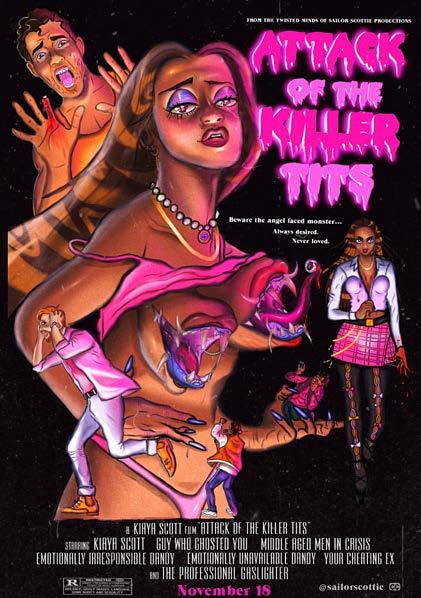


THE SUIT
by Tone-Lise
The suit is designed as a costume for the short film “Without Perfection” (Danish: “Hvis Ikke Jeg er Perfekt”), directed by Vega Moltke-Leth and produced by Gode Dage. The film explores cultures of perfectionism and the anxiety it causes in young women today.
The suit is reworked from one of the director’s own suits and highlights the complexity of being a career woman. It has phrases printed on it - statements and opinions - that people have had about me as a woman and as a person, and on the inside I have printed the mind map Vega made when she was developing the film. Even though it’s made from the simple shapes of a suit, the prints provide a raw twist of societal critique, and reclaims the suit as a feminine article of clothing where women are taking their rightful place and power in the workplace.

BURNING ARMY
Many individually we hatch the world anew we stir up time we shed our shadow skin fire breaks out
– Verena Stefan, Shedding
by Vera Zimmermann
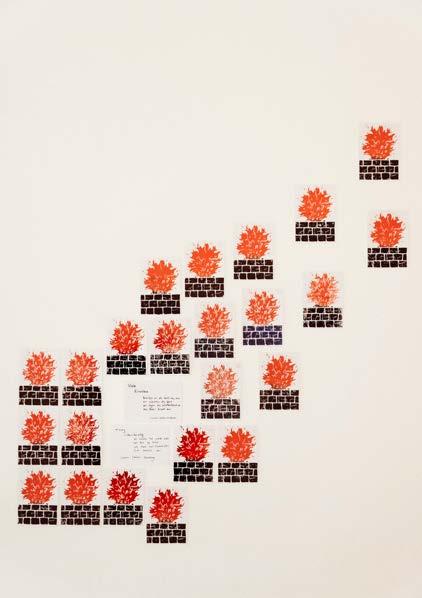

DUSK RITUALS
Dusk Rituals is an all-female alternative rock band based in Copenhagen. Sharing a passion for post-punk and dreampop, each member draws influences from diverse genres, collectively creating a distinctive sound. Their songs blend layered guitars, hypnotic melodies and evocative lyrics, weaved together by intertwining vocal harmonies. Dusk Rituals is about sisterhood, co-creation and mystic - a collective of women gathering at sunset to create something shared and a bit mysterious.
Hailing from different corners of the world, its four members found their paths converging in Copenhagen in 2023.
LISTEN TO DUSK RITUALS HERE

forethought on a Dream
a Dream that I have come to know in every detail is due to be dreamt in three days, perhaps four. birds are floating beneath them. i know those mountains from my mother’s embrace. i didn’t believe it then but yes, only monks on mount athos. the women all banished from Mary’s Garden. even beasts, all gone but Songbirds, impossible to be kept out, though capable of hatred; and so refusing to sing. only within uphill branches they reveal a chorus to Mary. one must imagine her lonely. my mother hisses: “μην το λες αυτό!”, no, for god would hear everything. and she, who takes great pride in bearing in silence – this painful birth – what was it for? now

this dream: two women’s feet on dry soil, burst pomegranate seeds oozing out of the rooster that wanted them gone. one woman dances. unholy! yet bodies transform to tossing themselves across dust. no prayer keeps anything from being dreamt, unholy perhaps, but their mouths do not care, the heartbeats neither; trilling beaks above, a tongue, further left: what was once a shrub; and afterwards one braids the other’s hair, and goes on to hum the next bird’s melody. some might think it sin, that soil stuck to where they’ve met. but Mary isn’t all that mad about it, not that mad at all.
by Eleni Gemitzis
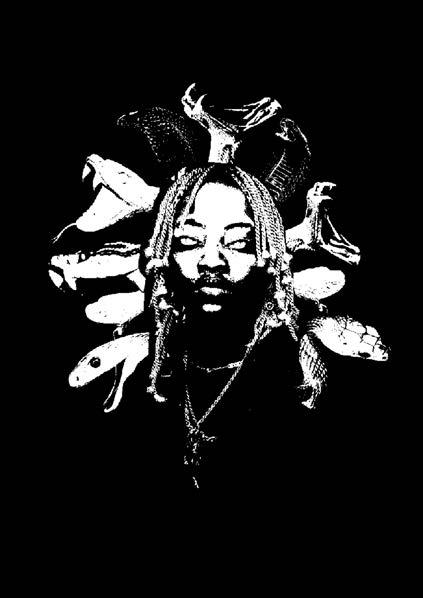
Letter to Medusa is a text original written in Danish and then translated to English as part of a video installation. The text is about sexual violence and abuse and uses the Medusa myth to talk about the topic in a contemporary Danish context.
If you want to read more about the video installation go to Momo Mentha’s website: https://www.momomentha.com/we-medusa-and-i
Brev til Medusa
Lad ham der rejser sig og komme vider fortælle historien mens du lever med konsekvenserne I ensomhedens voldelige skygger.
Dette fortalte du mig, at de havde fortalt dig.
Jeg tænker tit på dig, på vores samtaler og hvad der siden hen er hændt dig. Du er I os alle og selv om du ikke er I mit liv længere,er du en del af mig, en del af os alle der har fået byrden af voldens konsekvenser som følgesvend.
Folk som dig lever ikke længe fortalte du mig, og jeg forstår det godt.
Jeg vil male dit portræt på politistationen, lad dit blik våge over dem der skulle have beskyttet dig, så de husker at beskytte os.
Jeg gemmer mig I dit blik for at søge beskyttelse fra de onde øjne, dem der tog min menneskelighed. Du som måtte gå med solbriller for at beskytte verden mod dit forstenende blik, for din vrede kunne verden ikke tåle, din smerte hørte ikke hjemme.
Du fortalte mig om dit liv hvordan folk mødte dig efter.
Du sagde du var bange for at betræde dit eget land, så bange for at møde ham igen at du måtte gemme dig, og han svarede dig, at den modbydelige altid havde været en stakkel.
Det var synd for ham at du forlod manden der stjal din sjælefred, hvor kunne du gøre det mod sådan en stakkels mand?
Verden er ikke klar til din smerte, til at du siger fra, derfor er du monsteret, når folk ser på dig, ser de hvordan samfundet har fejlet, så er det bedre slet ikke at se på dig.
Et samfund bygget af dem der kan fortælle historierne.
Lad mig fortælle verden din, for du lever I mig hver dag. Og om det så skulle blive min ende, vil jeg leve et liv uden solbriller, uden at skulle skærme verden for dens grusomhed.
Hvis de ser på os og forstenes af deres eget spejlbillede, så lad dem stå forstenet til de er færdige med at konfrontere sig selv.
Hårspray er lovligt, det er peberspray ikke fortæller politiet, det var det bedste de kunne komme på efter de pressede dig til at skærme ham fra konsekvenserne af egne handlinger, det er jo synd for ham, han er jo syg. Og du havde overlevet umenneskelige ting så du måtte være så stærk at du kunne bære konsekvenserne for alle involveret. Det var ikke nok at skulle gennemleve volden hver dag, at se dig selv forstenet og modbydelige onde øjne stjæle din menneskelighed, du må bære hans skyld oven på din egen smerte, og du måtte bære politiets uduelighed oven i.
Hvor er du nu? Dette spørgsmål stiller jeg ofte mig selv. Jeg håber det er bedre, jeg håber du ikke skal gå gennem verden alene mere. Du sagde at folk som os ikke lever længe, og jeg ved hvorfor, men jeg vælger at håbe på at du går mod et liv der er dig værdigt, at du ikke pålægges andres skam for evigt.
Jeg håber du sider et smukt sted under midnatssolen, omringet af folk der elsker dig. Jeg håber at du er okay. Når du ser på mig, ser du dig selv, og jeg ved det kan blive tungt, Jeg bebrejder dig intet.
Jeg husker da vi mødtes I forårssolen, du spurgte hvilken medicin jeg tog og faldt mig grædende om halsen, for du vidste hvad det indebære. Vi deler ikke længere samme sti, men jeg ser dig I andres blikke. Vi genkender hinden, vi nikker som en trøst og går videre.
by Momo Mentha
Letter to Medusa
Let he who gets up and move on tell the story while you live with the consequences in the violent shadows of loneliness.
You told me they had told you this.
I often think of you, of our conversations, and what has become of you since.
You are in all of us. And even if you are no longer in my life, you are a part of me, a part of all of us, burdened with the consequences of violence.
People like you do not live long, you told me, and I understand why. I want to paint your portrait in the police station; let your gaze keep watch over those who should have protected you, so they remember to protect us.
I hide in your gaze, to seek protection against the evil eyes, those that took my humanity. You who had to wear sunglasses to protect the world against your petrifying gaze. Because the world could not bear your anger, your pain did not belong. You told me of your life, about how people treated you after.
You said you were afraid to set foot in your own country, so scared of meeting him again, that you had to hide, and he told you that the reprehensible had always been a poor wretch.
It was hard on him, that you left the man who stole your peace of mind, how could you do it to the poor man?
The world is not ready for your pain, for your objection. Therefore, you are the monster. When people look at you, they see how society has failed. Then it is better not to look at you at all.
A society is built by those who can tell the stories.
Let me tell the world yours, for you live in me every day. And even if it is the end of me, I will live a life without sunglasses, without having to shield the world from its own cruelty.
If they look at us and become petrified by their own reflection, then let them remain petrified until they are done confronting themselves.
Hairspray is legal, pepper spray is not, the police say. It was the best they could come up with after they pressured you to shelter him from the consequences of his own actions, he is to be pitied, he is ill, after all. And you had survived inhumane things, so you must be strong enough to shoulder the consequences for all involved. It was not enough that you had to live through the violence every day, see yourself petrified and the despicable evil eyes steal your humanity. You had to carry his guilt on top of your own pain, as well as the incompetence of the police.
Where are you now? I often ask myself this question. I hope it is better, I hope you do not have to go through the world alone anymore. You said that people like us do not live long, and I know why, but I choose to hope that you are heading for a life that is worthy of you, that you are not charged with others’ guilt forever.
I hope you are sitting somewhere beautiful under the midnight sun, surrounded by people who love you. I hope you are okay. When you look at me, you see yourself, and I know it is hard, I do not blame you for anything.
I remember when we met in the sunshine of spring, you asked what medicine I took, and you threw your arms around me, sobbing, for you knew what that meant. We no longer share the same path, but I see you in the eyes of others. We recognize each other, we nod to each other in consolation and walk on.
translated by Stinne Brøchner-Nielsen
Death in a Postwar High Rise on Main Street
I was once frigid. I didn’t understand what had happened to me. I thought I might be gay. I thought I might be asexual. I’d been reading about women’s frigidity all over the internet, combing through voices of confused women, what’s happening to me, and resentful men convincing themselves of some imaginary deception — she pretended to be a nympho in the beginning to trap me. Now? Nothing.
But there was no trick, only a death.
He wasn’t a man. He was a pile of dirty dishes in the sink, the stale, musty scent of a hamper filled with dirty laundry, an unmade bed with sheets covered in sex as mechanical and mundane a chore as emptying the dishwasher or taking out the trash.
He wasn’t a man. He was the sneering contempt of the golden son still latched to his mother’s breast, and a relentless campaign of criticism — his mother didn’t fold his shirts that way — and more criticism masked as well-intended advice.
I don’t think you’d make a good mother, he’d told me one afternoon as I was staring out the window of the high rise I was trapped in, grieving my own recently deceased mother in a peaceful silence, eating a bowl of cereal. I was remembering how I inhaled her deeply one morning a few months earlier as she lay dying in her bed, hoping to be comforted by her signature jasmine scent. instead, I smelled her imminent death. She was ashamed when she felt my deep inhale into her neck, and said to me in a sad voice that she didn’t smell like herself anymore. I told her she always smelled beautiful to me — and I was staring out the high rise window thinking about how I wasn’t lying when I said that, hoping she knew, promising her once again that I meant it.
When I opened my mouth to cry, Oedipus explained that he only said it out of love. And how lucky I felt to be loved, despite all my faults he readily pointed out everyday.
I’ll be better, I scolded myself daily, determined. I’d convince him of my worth and in the meantime be so grateful that he could love me in all my incompetence and inferiority. But despite the millions of excuses I made for my situation, or because of the millions of excuses I made for him, my fault, my fault, always my fault — I fell sick.
At first, I didn’t notice the creeping anger — I thought I was happy, I told myself it was like playing house just as I had when I was a little girl. He noticed, though, when he asked me one day why I always cringed when he touched me.
More and more days passed gazing out the window, daydreaming of jasmine, daydreaming of escape, the only intrusion, his voice—a pinprick to my skin. I realized I wasn’t a little girl playing house; I was playing captive, staring out the window, jealous of the birds. My body changed. I started feeling a nameless ache. It took on a name in time: eviscerating rage. He’d taken me, a woman with undomesticated passion and transformed me into a bubbling vat of acid. Food lost all taste, the only taste I knew was the battery acid in my mouth, and sex lost all its texture and caprices.
I was done. I realized this one night gazing at him asleep. I loved him most when he was sleeping. I wished he would just sleep forever.
I began plotting my escape and two years and three attempts later, I jumped out the window. My death was a quiet one.
It’s four years later.
I forgive myself now. I like to take long baths. I submerge my body into the hot water with just my nipples exposed, the cool air making them hard. I splash around. I touch myself and I feel pleasure.
Now that I know cold black rage, deadly as it is, I’m careful.
I like my rage white-hot, transient as it is intense.
by Tara
On running through quicksand / The weight of what should be
I feel like I‘m failing.
My algorithm tells me that a minimalistically designed house looking over luscious green hills, baking souerdough bread (ideally for my husband) in a handcrafted wood-fired brick oven, daily meditations and yoga for self-love will make me happy.
A life with purpose and full awareness.
I feel like I‘m failing.
The most efficient cleaning hacks, smart devices with a myriad of functionalities and eco-friendly cleaning products presented in ASMR format.
Reset Sunday - a young man wipes his white high gloss coffee table and places his asthetically pleasing hard-cover books in a perfectly arranged matching colour scheme on top of it.
Reset and rewind, and do it all over again, forever and ever.
I feel inspired. Aspire to be a bit more like the guy in the modern high-ceiling apartment with floor to ceiling windows and designer furniture. I go to Amazon and buy all the stuff I saw in the ads, just to wake up drained after a 40 hour work week, and convince myself that the flat actually doesn’t look all that bad yet.
Because in reality I don‘t have any energy left. And I can’t be bothered.
In reality, I can‘t be bothered to do much of anything most of the time.
I scroll through Instagram once again.
Andrew Tate is establishing his own political party in the UK - BRUV. A man convicted for human trafficking and deeply misoginistic, dangerous views wants to go into politics. Sounds familiar. Against my former conviction that we wouldn’t ever let anything like that happen, I ask myself for a brief moment if it‘s possible that he gets into power.
I close Instagram and plan on doing a social media detox. On using my time purposefully.
But where do I even begin? I can‘t do everything, there’s not enough time. Cause I put most of my time into a job in finance (my inner kid would barf) and try to convince myself that it’s just a means to the end of one day becoming free. Or free-er.
I treat myself to expensive cocktails in fancy bars, buy a new flatscreen tv and book trips abroad, compensating for the sacrifices I‘m making and grasping obliviously at what I think it must be like to live free of existential worries.
And in the end, all I‘m doing is make myself ever so dependent on the very structure (is it safety or is it a prison?) that I‘ve built for myself. Or have I?
Sometimes I blame myself. Sometimes I blame the system. When I was younger, I blamed my parents. Beacuse they didn’t manage to - or even try to - become financially „free“. Because now I have to suffer the consequences.
I am stuck. Stuck in regret about lost years doing office jobs and listening to bad advice from bitter people. Stuck in self-pity cause my body is literally in pain everyday living the life I live.
All the would-haves and should-haves looming over me, sticky like chewing gum.
And then there‘s the could-dos and woulddos. And then there‘s paralysis.
But there‘s always Instagram.
by Sophie S.

CONTRIBUTORS
AJ Duncan @ajd.illustrates
Alva Guzzini @alvaguzzini
Anastasia Kluge @anastasia.kluge
Anna Leander
Annika Hyeonjin Julien
Arianell Boudry @ari.bou_
Arielle Rose Khosla @ariellerosekhosla
Cally Lim @sh_ttysoliloquy
Caroline Motley @cwmotley
Clara Josephine Lykkeberg @clara. lykkeberg
Dan Aries @heatherishz
Dusk Rituals @duskrituals.band
Eleni Gemitzis @elenigemitzis
Emily Bisgaard @emilybhk
Erica Engdahl @erica.engdahl
Farah Bejdadi @farahelein
Georgia Evans @georgiaevans__illustrations
Giovanna Saturni @glyrae
Hailie Cochran @vanhailie
Hannah Corsini @hannah.corsini
Izzy Blankfield @izzyblankfield
jane katzmann @l.e.a.v.e.s
Johanne Pi @atelier_johannepi
Julia Marie @ailujalien
Juliana Stankiewicz @julianas.artwork
Keni Nooner @noonerkeni
Kiaya Scott @sailorscott
Laura Griss @itslawrah
Liz Walker @everybodylikesliz
Liza Shkirando @liza.shkirando
Lottie McGowan @disturbi.art
Mädchen Vivi @madchen.vivi
Mai Hedvig Lyngby @mai_hedvig
Małgorzata Rumińska @megurum.art
Mathilde Betant-Rasmussen @mathilde.br
Mathilde Clear @mathildecpoetry_
Mike Haas @mikehaas._
Momo Mentha @momomentha
Myfawny
Myrto Apostolidou @myrto.apost
Nadia Razali @nadiadrazali
Nathaniel Remon @n.gothic
Nicola Stebbing @nicola_ks
Prantip @powerpuffpatti
Roselil Aalund @roselilaalund
Ryleigh Avnet @ryleighavnetart
Sophie S.
Stefanie Lechthaler @steffischtrub
Tara @fjskdxhsz
Tone-Lise @_tonelise_
Troty @troty__
Tudse @tudse.n
Vera Zimmermann
Veruschka Haas @v.e.r.u
Zélie Lézin @leziezelin
RAGE COLLECTIVE
ALVA she/her

ART EDITOR
Alva Guzzini is an artist and a book and paper conservator in training, based in Amsterdam.
COREY she/her
OUTREACH + SOCIAL MEDIA
Corey Ruzicano is a writer, educator, and creative consultant from the San Francisco Bay Area, based in NYC.
ERNESTINE she/her

CULTURE EDITOR
Ernestine Boiling is an art historian based in London.

IZZY she/her
ACADEMIC EDITOR
Izzy Blankfield is a British PhD student and writer based in NYC.
JULIE she/her

GRAPHIC + WEB DESIGNER
Julie Savery is a multidisciplinary creator based in Berlin, with a background in dance and performance.

KENI she/her
DIGITAL EDITOR + EVENTS
Keni Nooner is a dedicated community builder with years of experience at the intersection of partnerships and social impact based in NYC.
LAURA she/her POETRY EDITOR

Laura Griss is a Chilean and German poet & writer based in Vienna and doing an MA in Comparative Literature.


LORENZA she/her SCIENCE EDITOR
Lorenza Foglia is a PhD Student in Biophotonics from Italy usually based in Copenhagen, but currently living in Boston and completing a visiting fellowship at MIT.
MATHILDE she/her POLITICS EDITOR
Mathilde Betant-Rasmussen works at the EU Commission on peace and security in subSaharan Africa and is based in Brussels.
NADIA she/her FOUNDER + EDITOR-IN-CHIEF

Nadia Razali is an Algerian-Danish feminist activist, facilitator, and writer based in Copenhagen.

ROSA D-J they/them GENDER + LGBTQIA+ EDITOR
Rosa Davies-Jones is a non-binary Brit, originally from London and currently based in Norwich, UK.
ROSA G she/they PARTNERSHIPS + EVENTS

Rosa Greiffenberg has a bachelor’s in gender studies and is currently studying for an MA in modern culture. She is based in Copenhagen.

ROSELIL she/her PSYCHOLOGY EDITOR
Roselil Aalund is a therapist based both in Copenhagen, Denmark and in San Diego, California.
VERUSCHKA she/her COMMUNITY + ENGAGEMENT

Veruschka Haas is a writer and copywriter from Munich, Germany based in Copenhagen.

ZELIE she/her OPINION EDITOR
Zélie Lézin is a modern languages teacher based in Canada.


Z IN E

